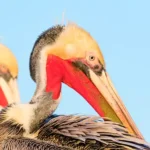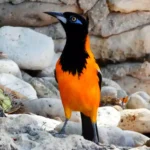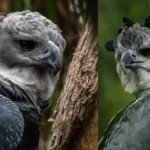Examine the stunning variety of 49 Red, Orange, and Yellow Birds in Louisiana with our detailed guide. Learn about these energetic birds that add a saturate of color to Louisiana’s various ecosystems.
12 Red Birds in Louisiana:
1. Summer Tanager:
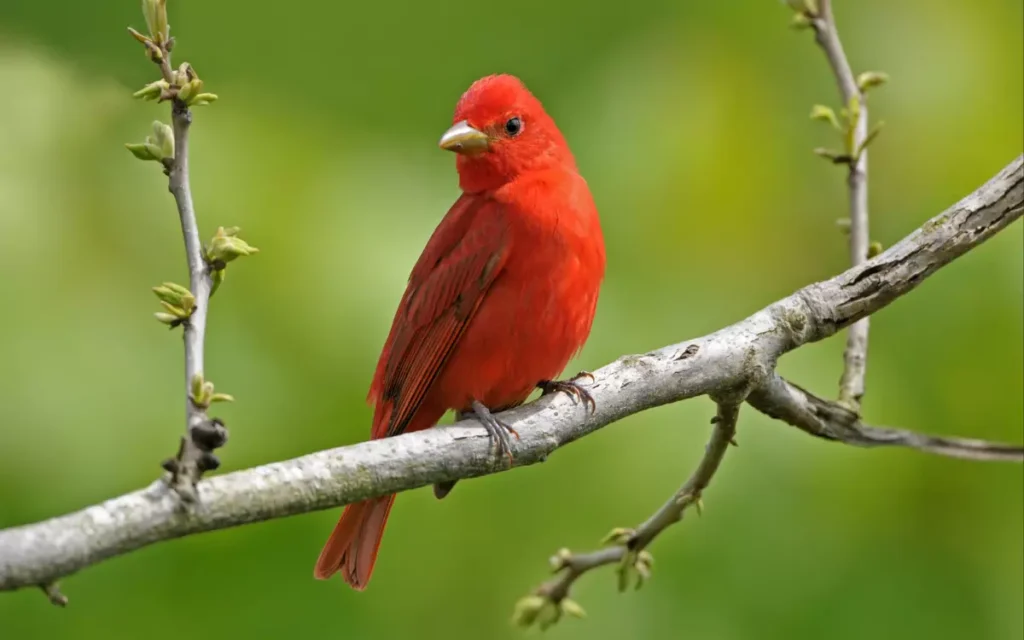
The Summer Tanager, a bird that embodies the essence of a Louisiana summer, graces the state with its presence for a significant portion of the year. Its vivid red plumage and melodious songs make it a cherished sight for bird enthusiasts.
Yearly Presence: Summer Tanagers typically arrive in Louisiana in late spring, staying until early fall. Their extended visit ensures that birdwatchers have ample opportunities to admire their stunning red plumage.
Breeding Time: Their breeding season coincides with their arrival, usually commencing in May. During this time, they become more active and vocal as they seek mates and establish nests.
Red Plumage: Summer Tanagers exhibit a vibrant red plumage, which is particularly striking against the green foliage of Louisiana’s forests and wetlands.
Egg Laying: Female Summer Tanagers typically lay a clutch of 2 to 4 eggs in their nests as they prepare to raise their young.
- Piranga rubra
- Length: 6.7 in (17 cm )
- Weight: 1.0 -1.1 oz (29-30 gm )
- Wingspan: 11-12 in (28-30 cm)
2. Scarlet Tanager:
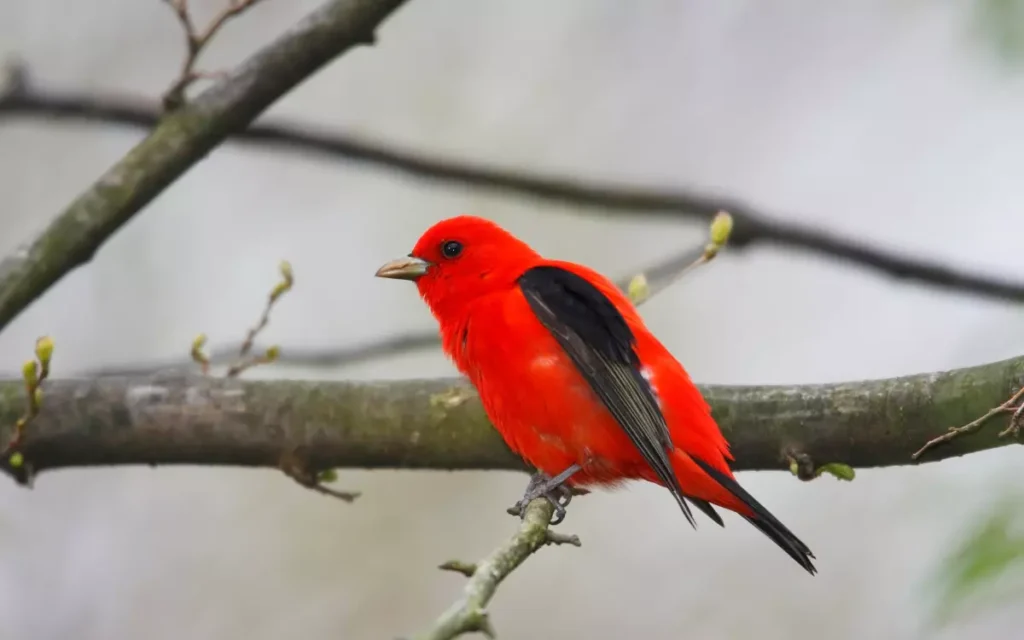
The Scarlet Tanager, adorned in intense red plumage, is a captivating but relatively brief visitor to Louisiana. Birdwatchers eagerly anticipate its arrival during the warmer months.
Yearly Presence: Scarlet Tanagers migrate to Louisiana in the spring, staying only during the warmer months when they display their brilliant red hues.
Breeding Time: Their breeding season aligns with their arrival in Louisiana during the spring, making this period the best time to observe their vibrant colors.
Red Plumage: Scarlet Tanagers are distinguished by their intense red plumage, making them stand out among the green foliage.
Egg Laying: Female Scarlet Tanagers typically lay 3 to 5 eggs in their nests as they prepare to nurture their offspring.
- Piranga olivacea
- Length: 6.3-6.7 in (16-17 cm)
- Weight: 0.8-1.3 oz (23-38 g)
- Wingspan: 9.8-11.4 in (25-29 cm)
3. Purple Finch:
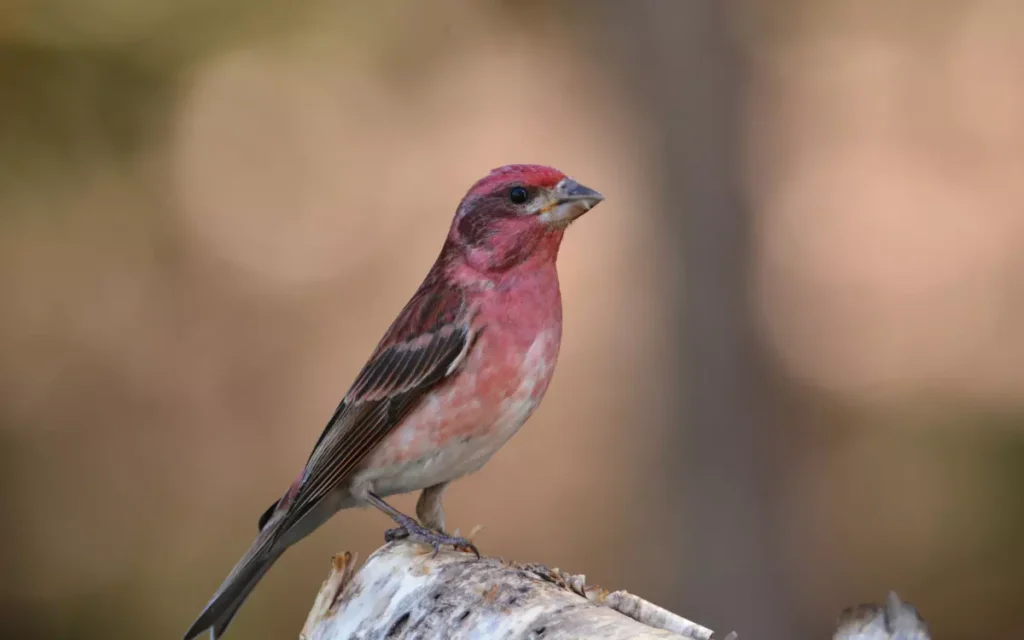
The Purple Finch, with its regal mix of crimson and purple plumage, is a unique and captivating presence in Louisiana.
Yearly Presence: Purple Finches migrate to Louisiana during the winter months, gracing the state with their vibrant presence during this season.
Breeding Time: Their breeding season typically takes place in northern regions, and they migrate south to Louisiana during the colder months.
Red Plumage: These finches showcase a blend of crimson and purple in their plumage, creating a stunning appearance.
Egg Laying: Female Purple Finches usually lay 2 to 5 eggs in their nests as they prepare to raise their young.
- Haemorhous purpureus
- Length:4.7-6.3 in (12-16 cm )
- Weight:0.6-1.2 oz(18-34 gm)
- Wingspan: 7-10.2 in( 18-26 cm )
4. Pyrrhuloxia:
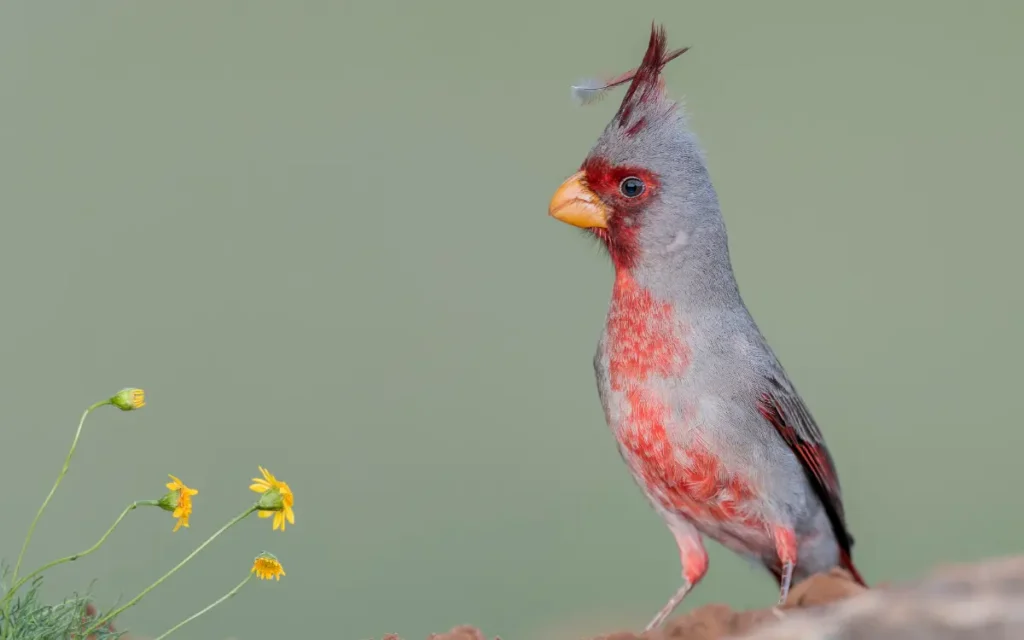
The Pyrrhuloxia, often referred to as the “desert cardinal” due to its resemblance to the Northern Cardinal, is a distinctive and year-round resident of Louisiana.
Yearly Presence: Pyrrhuloxias can be found in Louisiana throughout the year, making them a consistent and fascinating sight for birdwatchers.
Breeding Time: Their breeding season coincides with their year-round presence in the state, allowing bird enthusiasts to observe their behaviors up close.
Red Plumage: Pyrrhuloxias display a captivating blend of red and gray feathers, setting them apart from their feathered counterparts.
Egg Laying: Female Pyrrhuloxias typically lay 2 to 3 eggs in their nests as they prepare to nurture their offspring.
- Cardinalis sinuatus
- Length:8.3-8.7 in (21-22 cm )
- Weight:0.8-1.5 oz (24 – 43 gm)
- Wingspan:12.2 in (31 cm )
5. Cassin’s Finch:
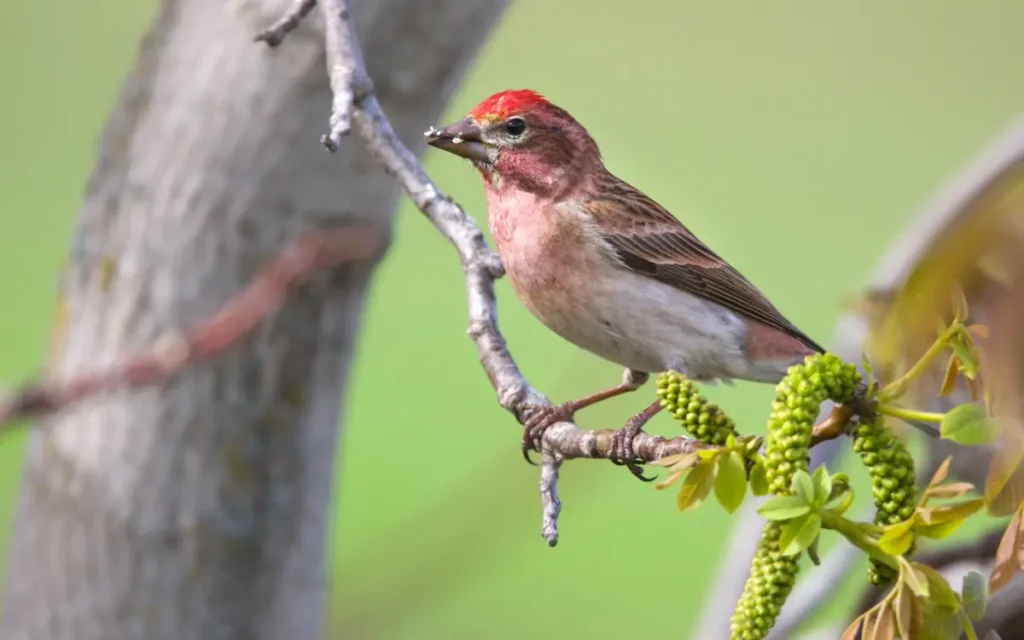
Cassin’s Finch, with its charming mix of red and brown plumage, is a unique addition to Louisiana’s avian diversity.
Yearly Presence: Cassin’s Finches visit Louisiana during the winter months, providing birdwatchers with a delightful opportunity to spot these exquisite birds amidst the state’s natural beauty.
Breeding Time: Their breeding season typically occurs in the northern regions, but they migrate south to Louisiana during the winter.
Red Plumage: These finches exhibit an elegant blend of red and brown in their plumage, creating an exquisite appearance.
Egg Laying: Female Cassin’s Finches usually lay a clutch of 3 to 5 eggs in their nests as they prepare for the breeding season.
- Haemorhous cassinii
- Length: 6.3 in (16 cm)
- Weight: 0.8-1.2 oz (24-34 gm)
- Wingspan: 9.8-10.6 in (25-27 cm)
6. Hepatic Tanager:
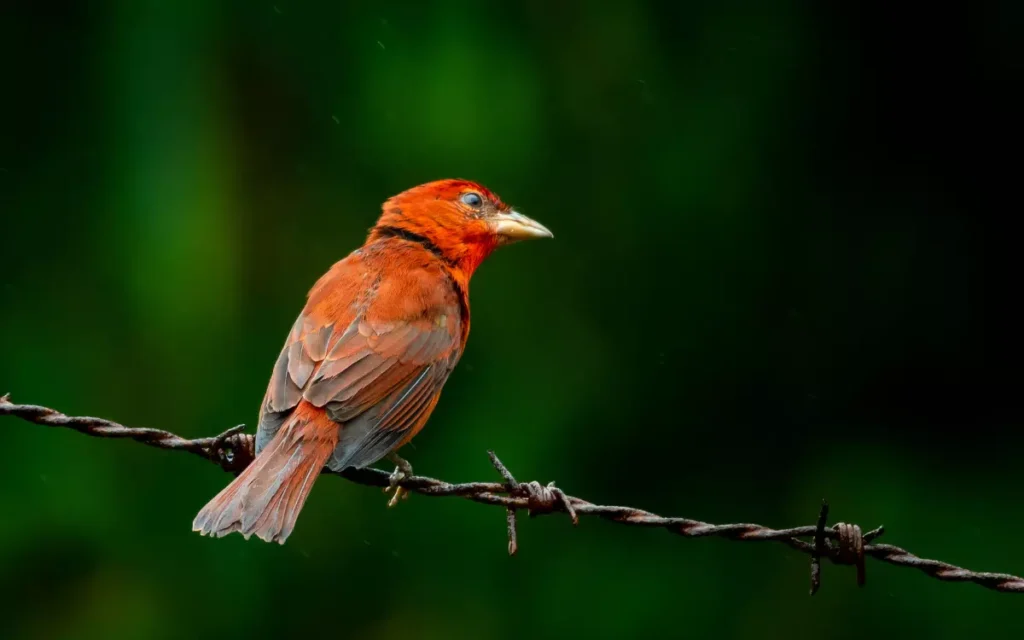
The Hepatic Tanager, with its subtle shades of red and brown, is a bird of understated beauty in Louisiana.
Yearly Presence: Hepatic Tanagers arrive in Louisiana during the warmer months, and their breeding season takes place in the western United States.
Breeding Time: Their breeding season aligns with their presence in the state during the summer.
Red Plumage: Hepatic Tanagers exhibit a delicate blend of red and brown feathers, giving them a unique appearance.
Egg Laying: Female Hepatic Tanagers typically lay 2 to 4 eggs in their nests as they prepare for the breeding season.
- Piranga flava
- Length:3.5 to 7.9 in (8.9 – 20.1 cm)
- Weight: 0.8 to 1.7 oz (22.7 – 48.2 gm)
- Wingspan:12.6 in (31.8 cm)
7. Painted Bunting:
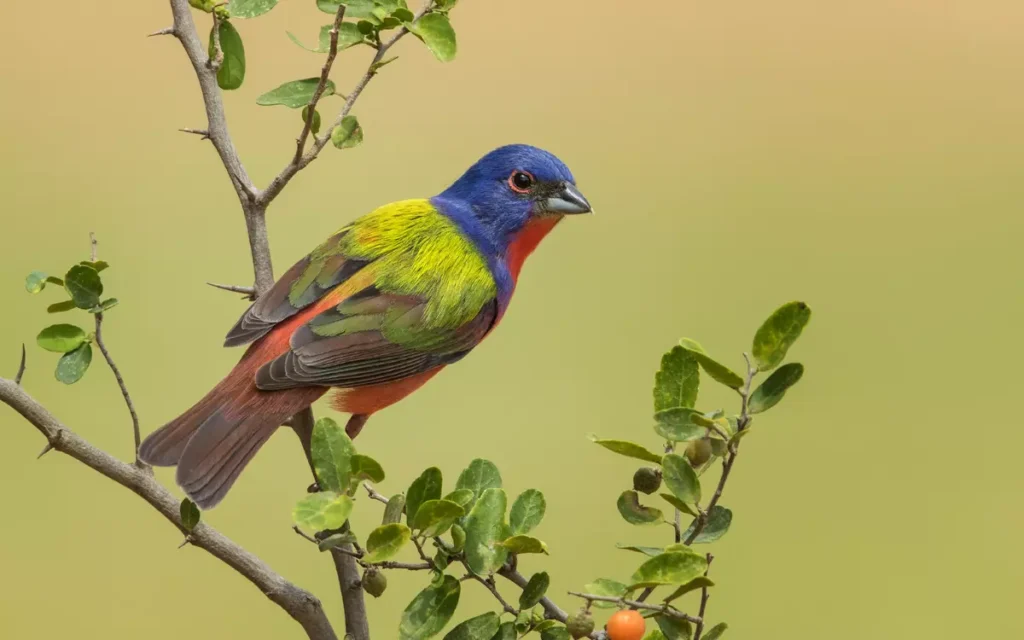
The Painted Bunting, with its vibrant red, blue, and green plumage, is a true marvel of nature in Louisiana.
Yearly Presence: Painted Buntings spend the summer months in Louisiana, adding a burst of color to the state’s natural landscapes.
Breeding Time: Their breeding season coincides with their presence in the state during the summer months.
Red Plumage: These buntings boast a kaleidoscope of colors, with males displaying bright red plumage.
Egg Laying: Female Painted Buntings typically lay a clutch of 3 to 4 eggs in their nests as they prepare to raise their young.
- Passerina ciris
- Length: 4.7 – 5.75 in (12 – 15 cm)
- Weight:0.5 – 0.8 oz (13 – 23 gm)
- Wingspan: 8 – 9 in (20 – 23 cm)
8. House Finch:
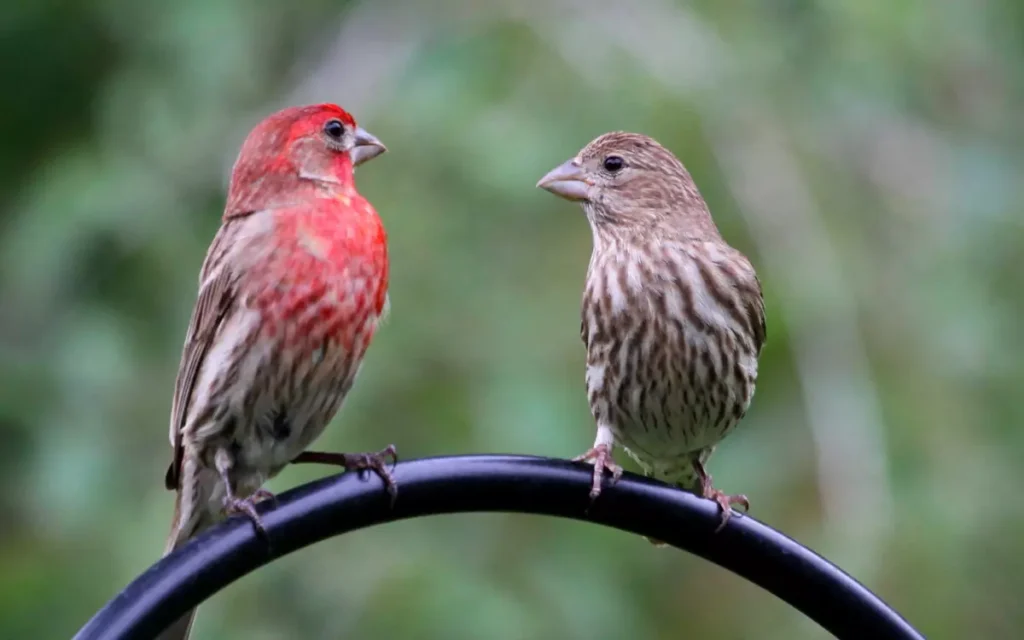
The House Finch, though not native to Louisiana, has established a presence in the state, showcasing its adaptability and charming red plumage.
Yearly Presence: House Finches can be spotted in Louisiana year-round, thanks to their ability to thrive in various environments, including urban areas.
Breeding Time: Their breeding season aligns with their consistent presence in the state throughout the year.
Red Plumage: House Finches display a vibrant red plumage, making them an attractive sight in gardens and urban settings.
Egg Laying: Female House Finches usually lay a clutch of 2 to 6 eggs in their nests, depending on the availability of food and resources.
- Haemorhous mexicanus
- Length: 5.1-5.5 in (13-14 cm)
- Weight: 0.6-0.9 oz (16-27 gm)
- Wingspan: 7.9-9.8 in (20-25 cm)
Similar Article: Red, Orange & Yellow Birds of West Virginia: A Visual Guide
9. Northern Cardinal:
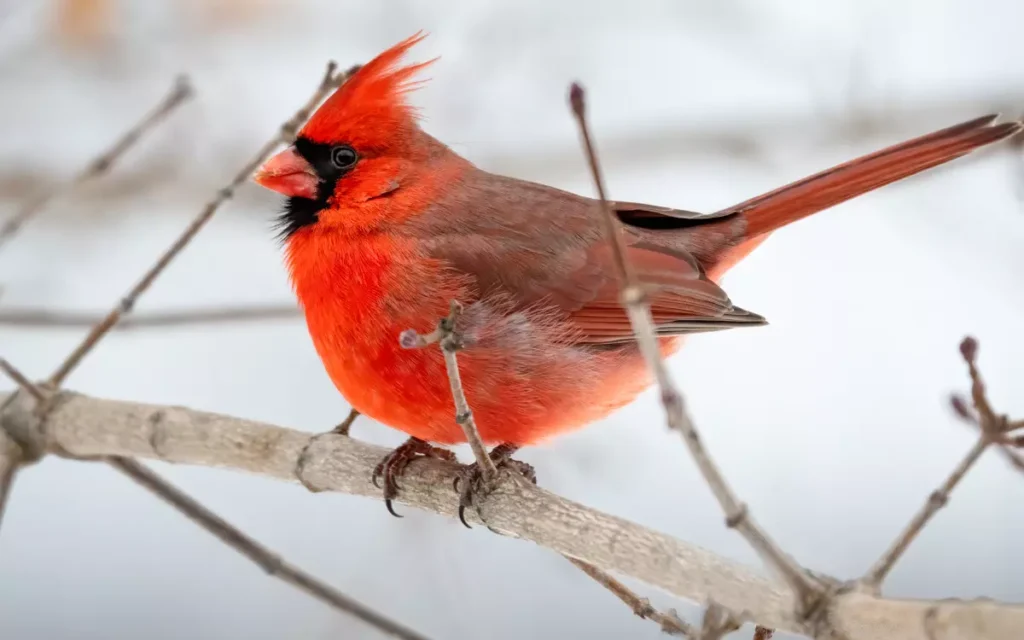
The Northern Cardinal, with its brilliant red feathers, is one of the most iconic birds in North America and a beloved resident of Louisiana
Yearly Presence: Northern Cardinals can be found in Louisiana throughout the year, gracing gardens and woodlands with their elegance.
Breeding Time: Their breeding season aligns with their consistent presence in the state, with pairs often seen engaged in courtship rituals.
Red Plumage: These cardinals are adorned in vibrant red plumage, with males and females both exhibiting this striking color.
Egg Laying: Female Northern Cardinals typically lay 2 to 5 eggs in their nests as they prepare to raise their young.
- Cardinalis cardinalis
- Length: 8.3-9.1 in (21-23 cm)
- Weight : 1.5-1.7 oz (42-48 gm)
- Wingspan: 9.8-12.2 in (25-31 cm)
10. Red-headed Woodpecker:
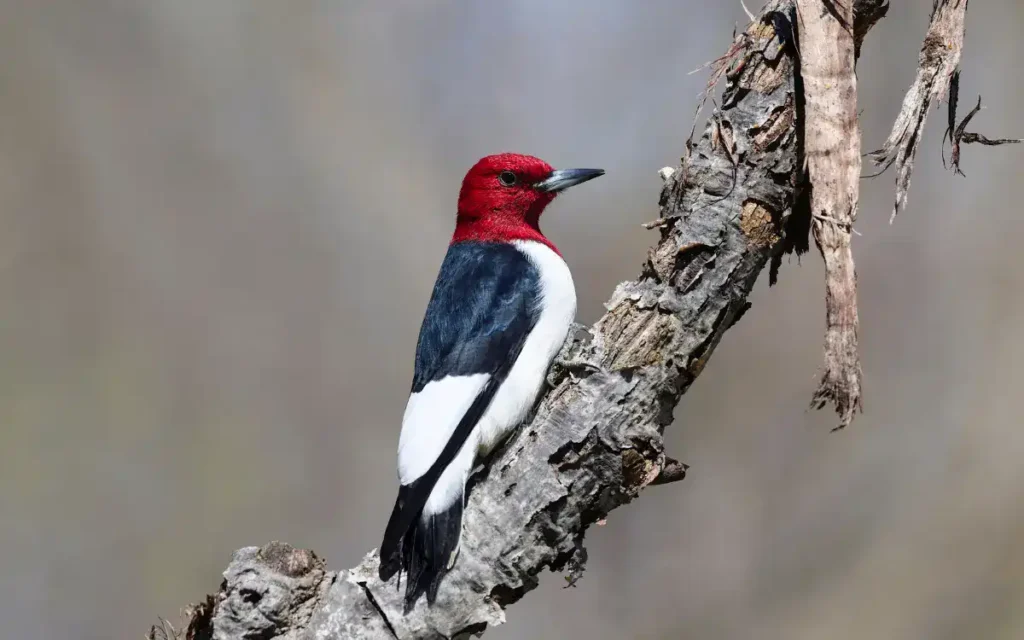
The Red-headed Woodpecker is a striking bird with a deep-red head and a contrasting white belly and wings. This woodpecker species is a year-round resident of Louisiana, delighting observers with its distinctive appearance.
Yearly Presence: Red-headed Woodpeckers can be found in Louisiana throughout the year, thanks to their adaptability to various habitats.
Breeding Time: Their breeding season aligns with their year-round presence in the state, allowing for consistent observations.
Red Plumage: These woodpeckers are characterized by their bright red heads, which contrast sharply with their white underparts and wings.
Egg Laying: Female Red-headed Woodpeckers typically lay 4 to 5 eggs in their nests as they prepare to raise their offspring.
- Melanerpes erythrocephalus
- Length: 7.5-9.1 in (19-23 cm)
- Weight: 2.0-3.2 oz (56-91 gm)
- Wingspan: 16.5 in (42 cm)
11. Rose-breasted Grosbeak:
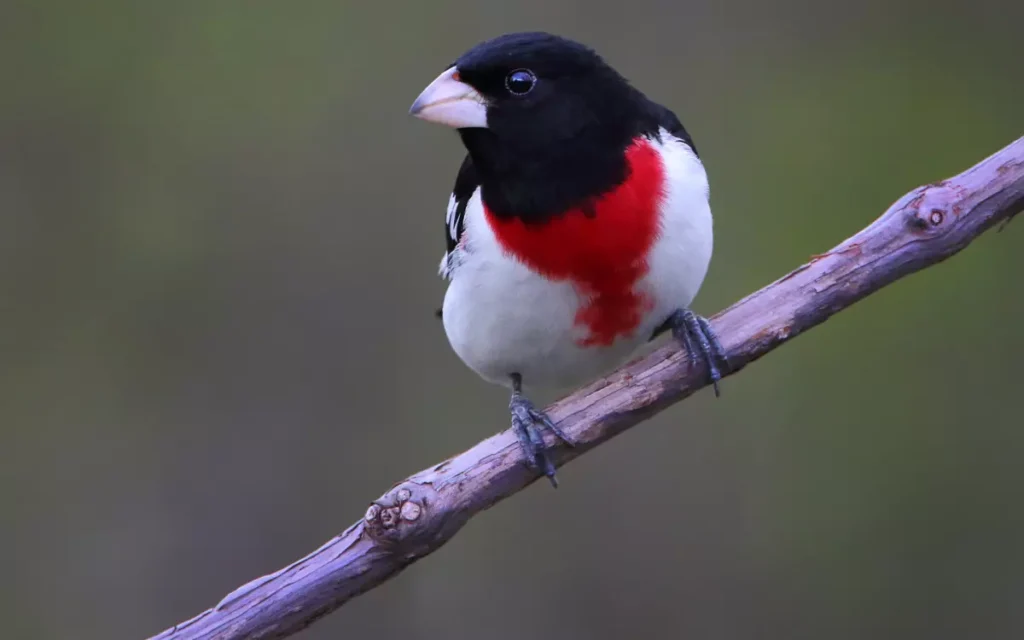
The Rose-breasted Grosbeak is a striking bird, named for the vibrant rose-red patch on its breast. It is a migratory visitor to Louisiana, adding color to the state during its seasonal visits.
Yearly Presence: Rose-breasted Grosbeaks arrive in Louisiana during the spring, staying until the late summer or early fall.
Breeding Time: Their breeding season aligns with their arrival in Louisiana during the spring months.
Red Plumage: These grosbeaks feature a stunning rose-red patch on their breast, complemented by black and white plumage.
Egg Laying: Female Rose-breasted Grosbeaks typically lay 3 to 5 eggs in their nests as they prepare for the breeding season.
- Pheucticus ludovicianus
- Length: 7.1-9.1 in (18-23 cm)
- Weight: 1.2-2.3 oz (35-65 gm)
- Wingspan: 11.4-13.0 in (29-33 cm)
12. Roseate Spoonbill:
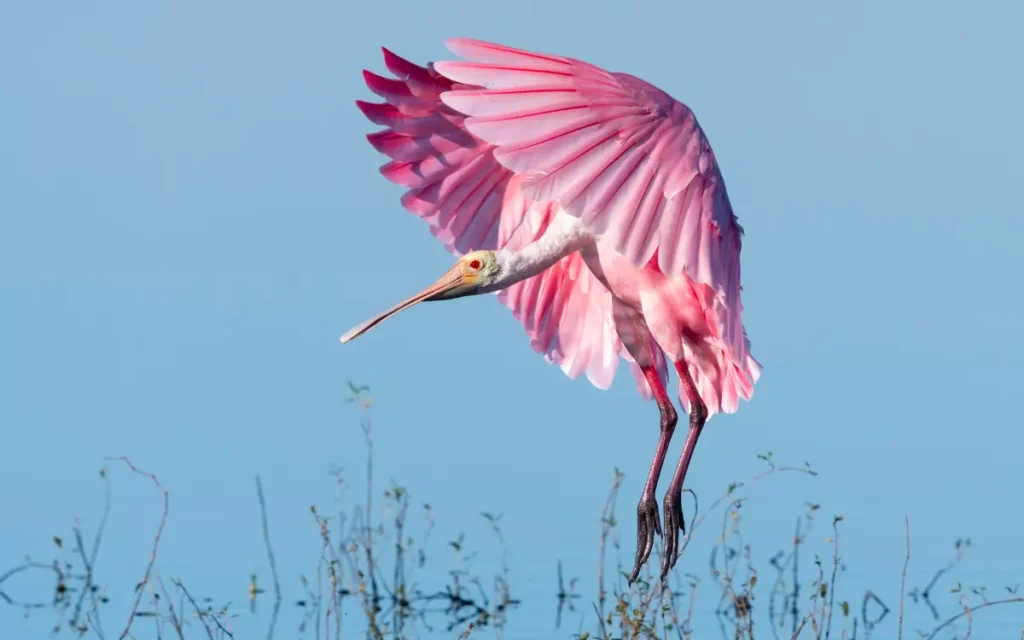
The Roseate Spoonbill, with its vibrant pink plumage, is a true spectacle in Louisiana’s wetlands and marshes. While not entirely red, its striking coloration earns it a place among these vibrant birds.
Yearly Presence: Roseate Spoonbills are year-round residents of Louisiana, making their stunning pink hues a consistent feature of the state’s wetland landscapes.
Breeding Time: Their breeding season typically occurs during the spring and summer months, coinciding with their year-round presence.
Coloration: Roseate Spoonbills are predominantly pink, with striking shades of rose and crimson in their plumage.
Egg Laying: Female Roseate Spoonbills usually lay a clutch of 2 to 5 eggs in their nests as they prepare to raise their young.
- Platalea ajaja
- Length: 27.9-33.9 in (71-86 cm)
- Weight : 42.3-63.5 oz (1200-1800 gm)
- Wingspan: 47.2-51.2 in (120-130 cm)
7 Orange Birds of Louisiana:
Louisiana boasts a rich avian diversity, and among the most captivating are its orange-hued birds. These birds are a delight to behold, not only for their vibrant plumage but also for their unique behaviors and roles in the ecosystem.
1. American Kestrel:
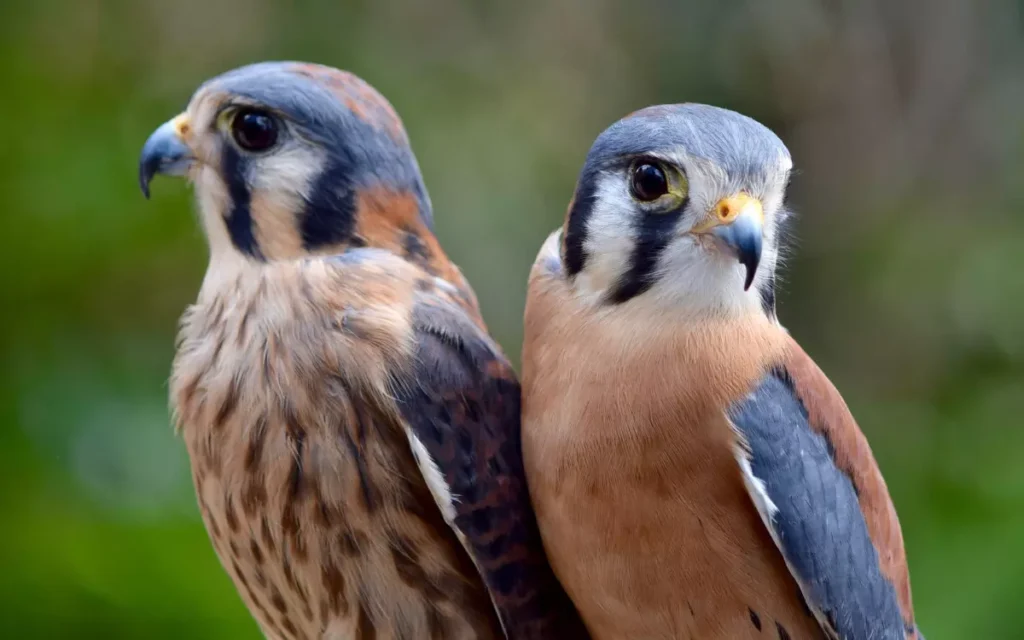
The American Kestrel, a small and agile falcon, graces Louisiana’s skies with its striking appearance and acrobatic flight. With its rusty orange plumage and distinctive black markings, this bird is a true spectacle.
Yearly Presence: American Kestrels are year-round residents of Louisiana, making them a familiar sight throughout all seasons.
Breeding Time: They breed in the spring, typically from March to June. During this time, they engage in elaborate courtship displays, showcasing their hunting prowess and agility to potential mates.
Coloration: The male American Kestrel displays bright orange-red plumage with contrasting slate-blue wings. In contrast, the female is slightly larger and has a reddish-brown hue with streaks.
Egg Laying: These birds typically lay a clutch of 3-7 eggs, which are incubated by the female for about 30 days. Once hatched, the chicks are fed regurgitated food by both parents.
- Falco sparverius
- Length:8.7-12.2 in (22-31 cm)
- Weight : 2.8-5.8 oz (80-165 gm)
- Wingspan: 20.1-24.0 in (51-61 cm)
2. Eastern Towhee:
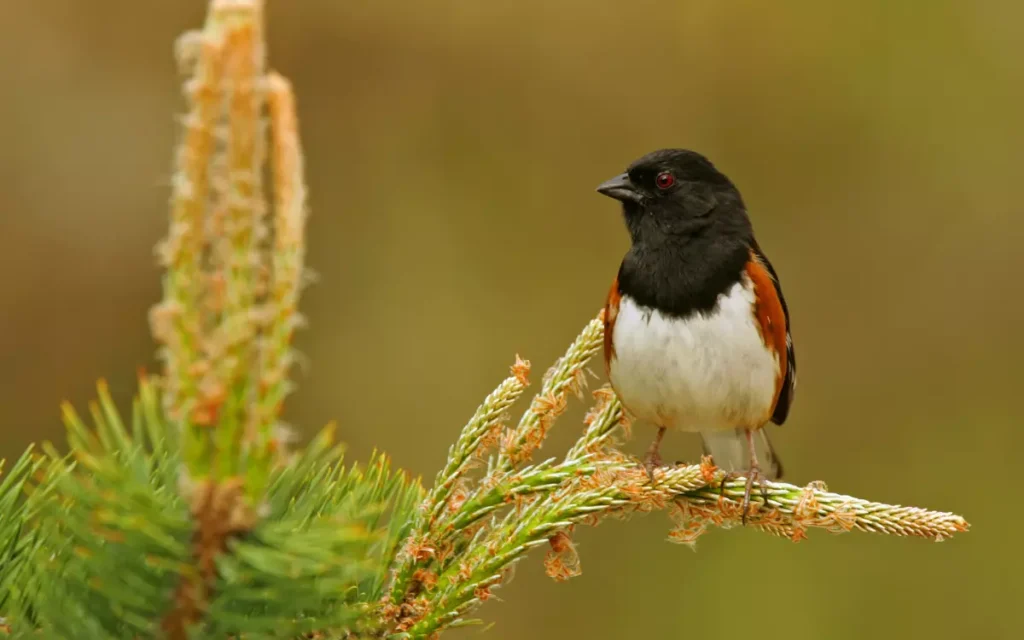
The Eastern Towhee, with its bold orange eyes and warm rufous sides, is a captivating songbird that frequents Louisiana’s woodlands and shrubby areas.
Yearly Presence: Eastern Towhees are year-round residents of Louisiana, offering their melodious songs throughout the year.
Breeding Time: They breed from late April to early July, building their nests in dense shrubs or low branches. During this time, they were known for their melodious and repetitive songs.
Coloration: The males boast black wings and striking rufous sides, making them easily distinguishable. Females have a more subdued coloration.
Egg Laying: Eastern Towhees typically lay 2-6 eggs, and the incubation period lasts about 12-14 days. Once the young birds fledge, they are nurtured by both parents.
- Pipilo erythrophthalmus
- Length: 6.8-8.2 in (17.3-20.8 cm)
- Weight: 1.1-1.8 oz (32-52 g)
- Wingspan: 7.9-11.0 in (20-28 cm)
3. Orchard Oriole:
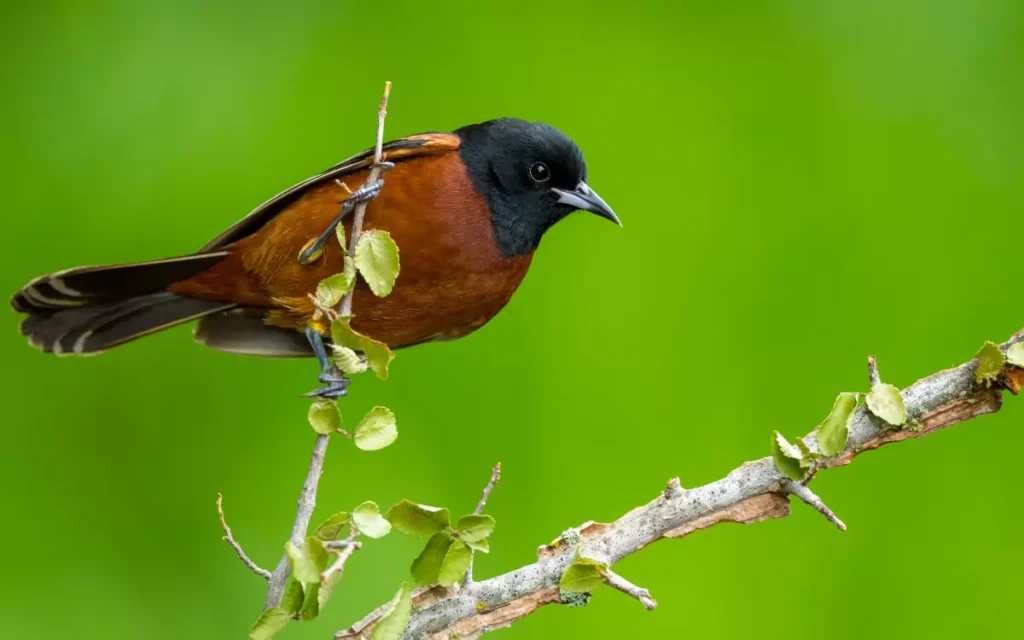
The Orchard Oriole is a charming bird with a bright orange hue and a melodious song. These birds can be found in orchards, gardens, and woodlands across Louisiana.
Yearly Presence: Orchard Orioles are seasonal visitors to Louisiana, arriving in late April and departing in early September.
Breeding Time: They begin breeding soon after their arrival, engaging in courtship displays and singing to attract mates.
Coloration: Males sport striking flame-colored plumage, while females are olive-green with yellowish underparts.
Egg Laying: Orchard Orioles typically lay 3-5 eggs, and the incubation period is approximately 12-14 days. Once the chicks hatch, both parents participate in feeding and caring for them.
- Icterus spurius
- Length:5.9 – 7.1 in (15-17 cm)
- Weight:0.6 to 1.0 oz (20-21 gm)
- Wingspan : 9.8 in (25 cm)
4. Ruddy Duck:
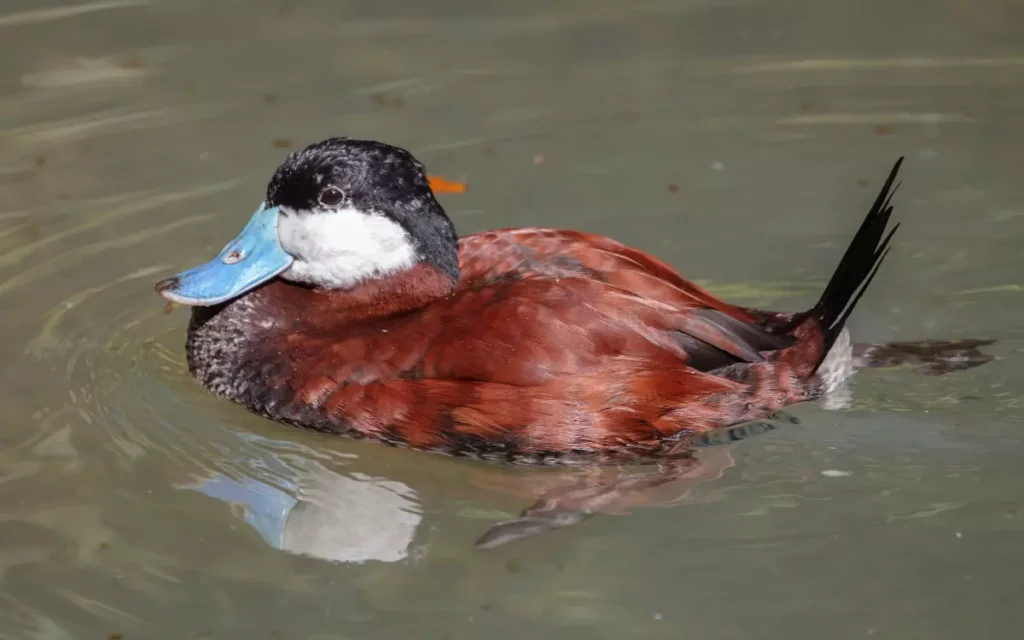
The Ruddy Duck is a small diving duck known for its distinctive rust-orange plumage, particularly during the breeding season. These ducks make a splash in Louisiana’s wetlands.
Yearly Presence: Ruddy Ducks are seasonal visitors to Louisiana, arriving in the fall and departing in the spring.
Breeding Time: Their breeding season usually starts in May and lasts through early summer. During courtship, males create a fascinating bubble display to impress females.
Coloration: Male Ruddy Ducks display rich chestnut-orange plumage during breeding, while females are more subdued, with brownish-gray coloring.
Egg Laying: Ruddy Ducks lay 6-15 eggs in a hidden nest near the water’s edge. Incubation takes about 23-26 days, and the ducklings are expert swimmers from a young age.
- Oxyura jamaicensis.
- Length:13.5 – 17 in (34 – 43cm)
- Weight: 11 – 30 oz (300-850 gm)
- Wingspan : 18.5 in (47 cm)
5. Rufous Hummingbird:
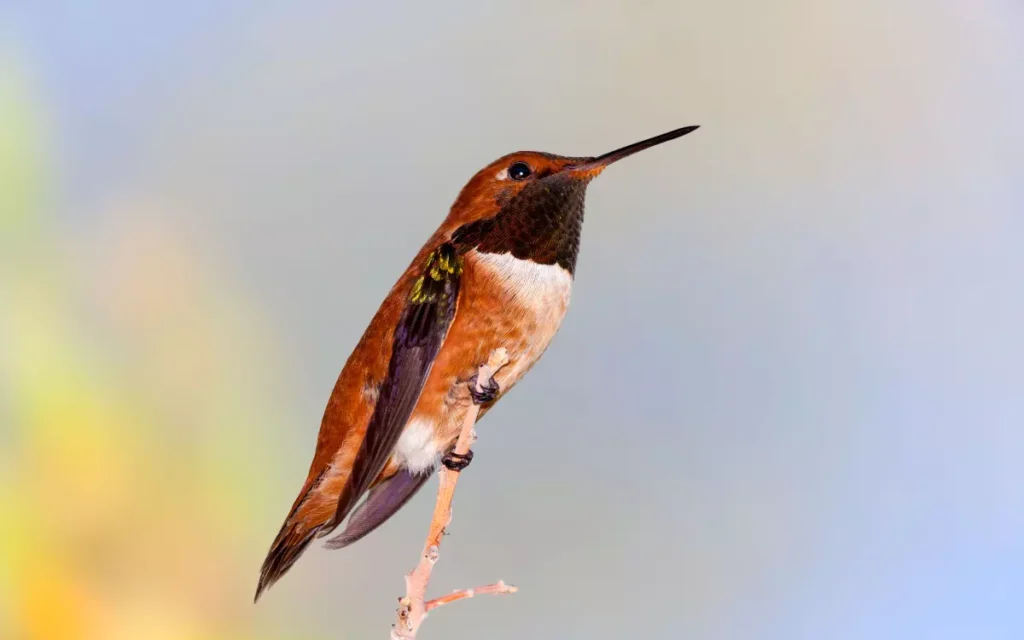
The Rufous Hummingbird is a tiny but fiery-orange bird known for its remarkable migration from Central America to North America, including Louisiana.
Yearly Presence: Rufous Hummingbirds are seasonal visitors to Louisiana, arriving in the spring and departing in the fall.
Breeding Time: They arrive in Louisiana in late spring and early summer, marking the beginning of their breeding season. These hummingbirds are highly territorial and engage in intense aerial battles.
Coloration: Male Rufous Hummingbirds exhibit bright orange-red plumage, while females are green with reddish markings.
Egg Laying: Females lay 2-3 eggs, and incubation lasts about 15-17 days. The female is solely responsible for pregnancy and feeding the young hummingbirds.
- Selasphorus rufus
- Length: 2.8 to 3.5 in (7-9 cm)
- Weight: 0.1 – 0.2 oz (2-5 gm)
- Wingspan : 4.3 in (11 cm)
6. Cooper’s Hawk:
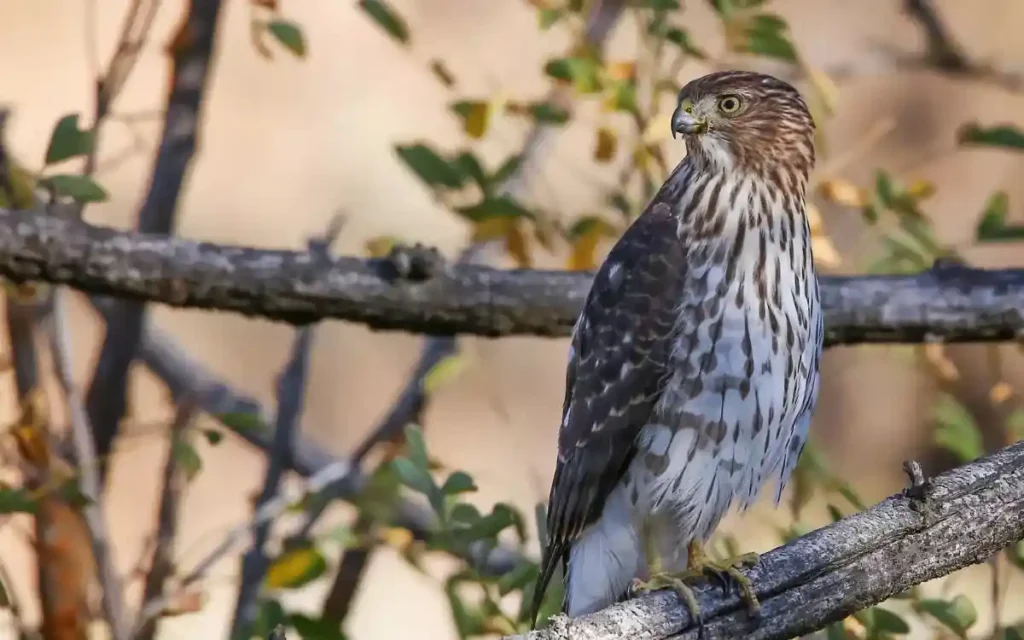
Cooper’s Hawks are skilled raptors with striking orange eyes and a distinctive slate-gray back. They are found in Louisiana’s forests and woodlands.
Yearly Presence: Cooper’s Hawks are year-round residents of Louisiana, making them a constant presence in the state.
Breeding Time: Breeding typically occurs from April to June. Cooper’s Hawks build nests in tall trees and are known for their impressive aerial displays during courtship.
Coloration: Adult Cooper’s Hawks have blue-gray backs and red-orange eyes. Juveniles have brown plumage.
Egg Laying: These hawks lay 2-5 eggs, which are incubated for about 30-36 days. The young hawks fledge after approximately 35-50 days.
- Accipiter cooperii
- Length :14.5 – 17.7 in (37- 45 cm)
- Weight: 7.8 – 24.0 oz (220-680 gm)
- Wingspan : 24 – 36 in (61-91 cm)
7. Barn Swallow:
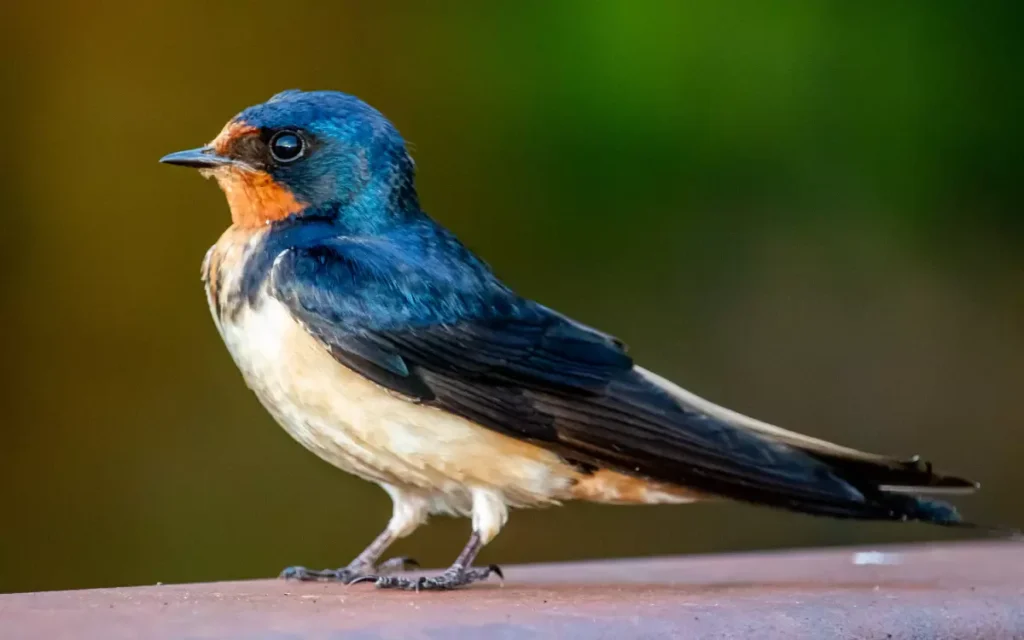
The Barn Swallow, with its vibrant orange throat and long forked tail, is a common sight in Louisiana’s open fields and barns.
Yearly Presence: Barn Swallows are seasonal visitors to Louisiana, arriving in the spring and departing in the fall.
Breeding Time: They arrive in Louisiana in March and start breeding in April. Barn Swallows are known for their intricate mud nests.
Coloration: Males have a striking orange throat (also called a “bib”) and dark blue plumage. Females are similar but with lighter coloring.
Egg Laying: Barn Swallows lay 3-7 eggs, and incubation takes approximately 13-17 days. Both parents feed the chicks once they hatch.
- Hirundo rustica
- Length: 6 -7.5 in (15 – 19 cm)
- Weight: 0.53 – 0.78 oz (15 – 22 gm)
- Wingspan : 11-14 in (29 – 36 cm )
30 Yellow Birds of Louisiana:
Louisiana’s bird population is rich and diverse, and among the most captivating are its yellow-hued birds. These birds not only bring a splash of color to the state but also play essential roles in the ecosystem.
1. Cape May Warbler:
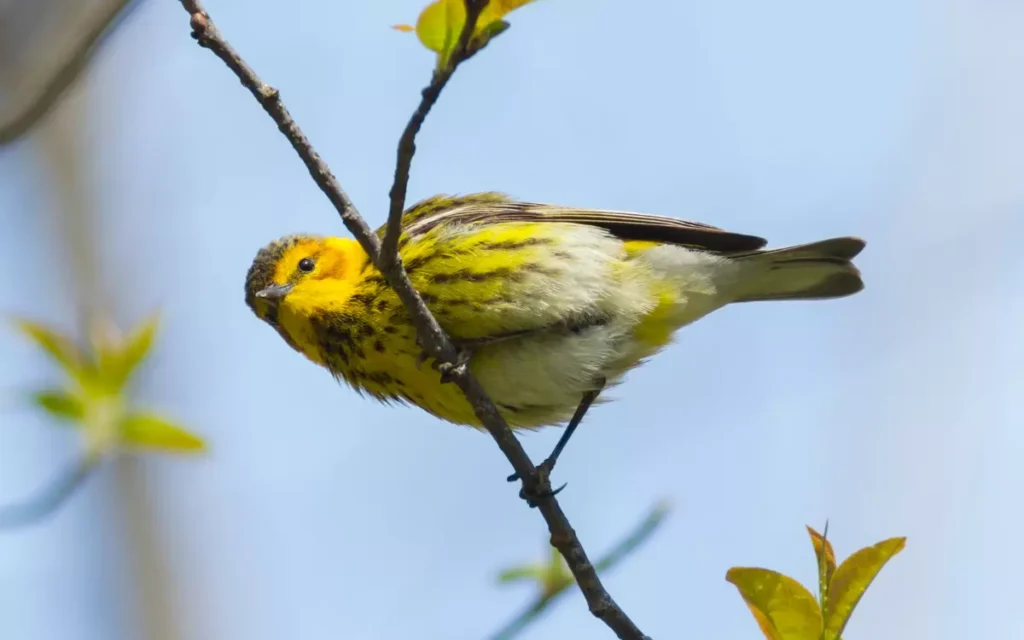
The Cape May Warbler is a delightful bird known for its bright yellow plumage and distinctive chestnut cheek patch. This petite songbird is a true gem in Louisiana’s avian diversity.
Yearly Presence: Cape May Warblers are seasonal visitors to Louisiana, arriving in the spring and departing in the fall.
Breeding Time: They start their breeding season in May when they migrate to their northern breeding grounds in Canada.
Coloration: Male Cape May Warblers exhibit vibrant yellow plumage with bold streaks on their chest and a chestnut cheek patch. Females have similar coloring but with a more subdued pattern.
Egg Laying: These warblers typically lay 3-6 eggs, and the incubation period lasts about 11-13 days. Both parents are involved in caring for the young birds.
- Setophaga tigrina
- Length: 4.7 – 5.5 in (12-14 cm)
- Weight: 0.36 – 0.61 oz (10.2-17.3 gm)
- Wingspan : 7.9 – 8.7 in ( 20 – 22 cm)
2. Western Meadowlark:
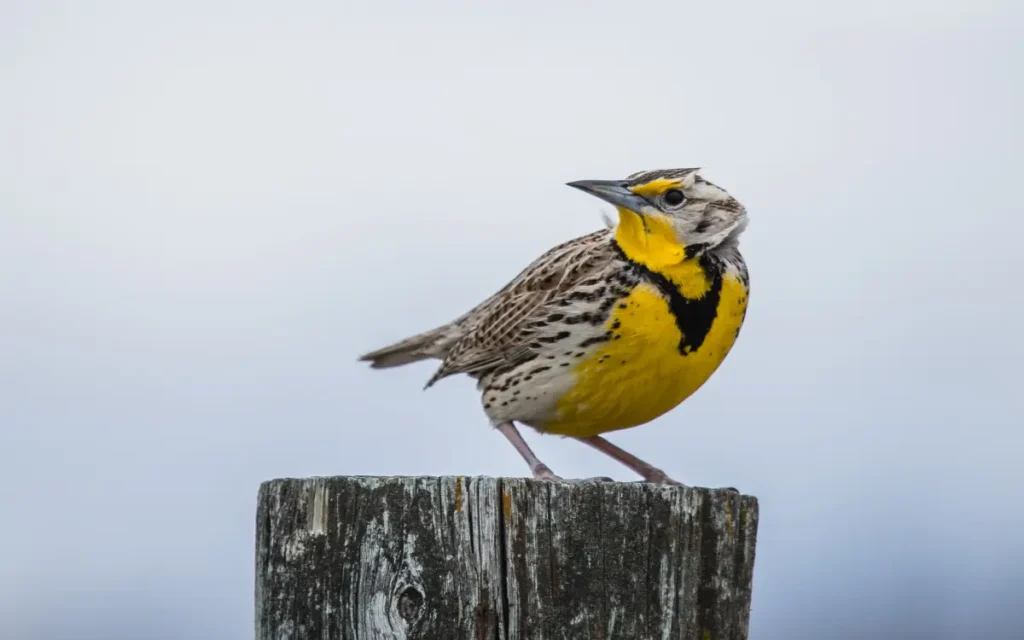
The Western Meadowlark is a splendid songbird with bright yellow underparts and a distinctive black “V” on its chest. Its melodious song is a symbol of the American prairies.
Yearly Presence: Western Meadowlarks are year-round residents of Louisiana, making them a common sight throughout the year.
Breeding Time: Their breeding season begins in late winter and extends into early summer, with some pairs raising multiple broods.
Coloration: These meadowlarks feature bright yellow underparts and a yellow throat with a black “V” on their chest. Their backs are brown with streaks.
Egg Laying: Western Meadowlarks lay 2-7 eggs, and the incubation period is approximately 12-14 days. Both parents share the responsibility of feeding and protecting their young.
- Sturnella neglecta
- Length: 6.3-10.2 in (16 – 26 cm)
- Weight:3.1- 4.1 oz (88-116 gm)
- Wingspan : 16.1 in (41 cm)
3. Yellow-headed Blackbird:
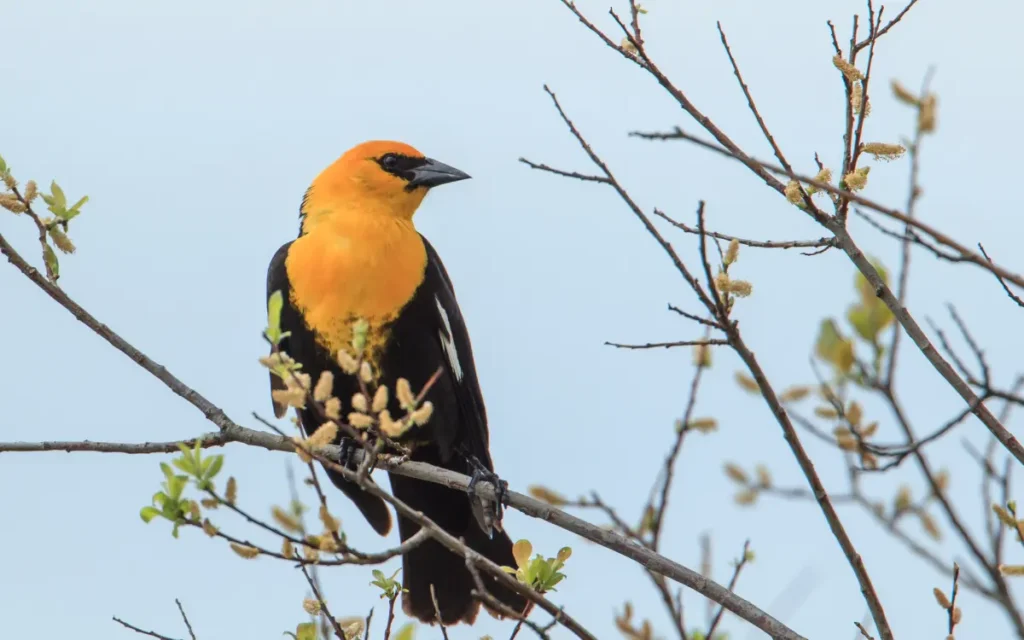
The Yellow-headed Blackbird is a striking bird with a vibrant yellow head and throat, making it easily recognizable among Louisiana’s avian residents.
Yearly Presence: Yellow-headed Blackbirds are seasonal visitors to Louisiana, arriving in late winter and staying through early spring.
Breeding Time: They begin their breeding season in May, with males showcasing their vibrant yellow plumage to attract females.
Coloration: Male Yellow-headed Blackbirds have bright yellow heads and throats, black bodies, and white wing patches. Females are more subdued with streaked brown plumage.
Egg Laying: These blackbirds typically lay 2-5 eggs, and incubation lasts about 12-14 days. Once hatched, the chicks are cared for by both parents.
- Xanthocephalus xanthocephalus
- Length: 8.3-10.2 in (21-26 cm)
- Weight: 1.6-3.5 oz (44-100 gm)
- Wingspan : 16.5 -17.3 in (42 – 44 cm)
4. Western Kingbird:
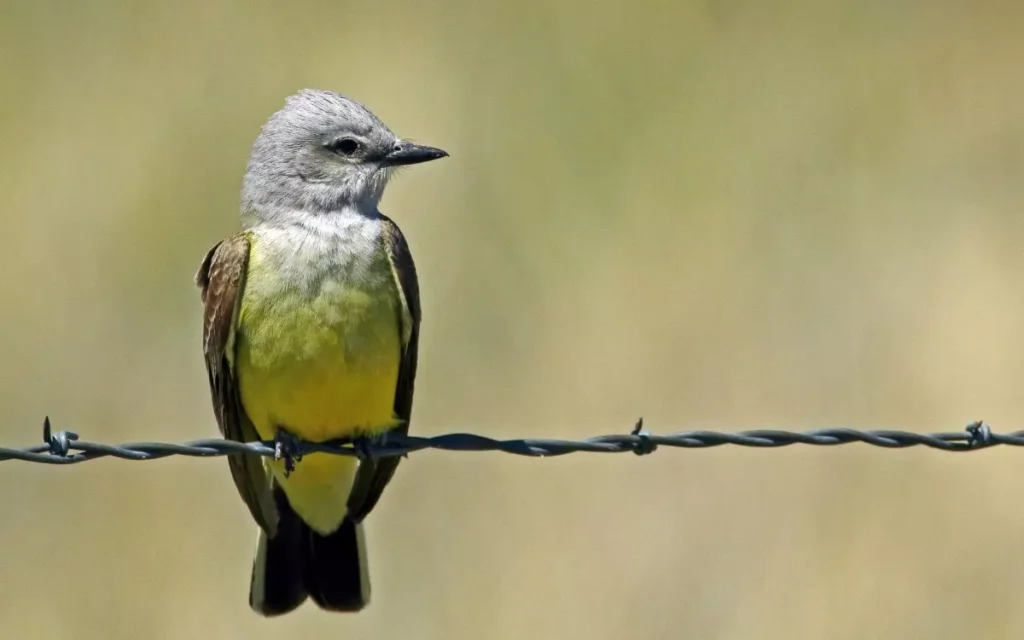
The Western Kingbird is a charming flycatcher known for its lemon-yellow belly and gray upperparts. These birds are skilled aerial hunters.
Yearly Presence: Western Kingbirds are seasonal visitors to Louisiana, arriving in the spring and departing in the fall.
Breeding Time: They begin their breeding season in May, constructing nests in trees or shrubs.
Coloration: These kingbirds have bright yellow bellies, gray backs, and white throats. They are known for their distinctive white outer tail feathers.
Egg Laying: Western Kingbirds typically lay 2-5 eggs, and incubation takes about 15-18 days. Both parents actively participate in feeding their young.
- Tyrannus verticalis
- Length: 8.75 in (22.2 cm)
- Weight: 1.4 oz (40 gm)
- Wingspan : 15.5 in (39.4 cm)
5. Nashville Warbler:
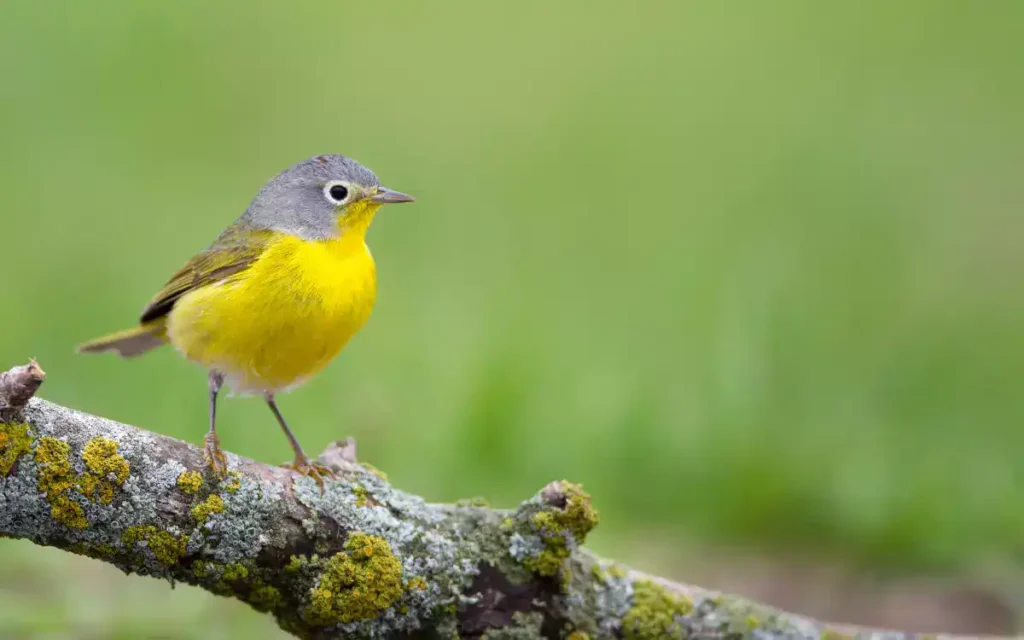
The Nashville Warbler is a delightful migratory songbird with bright yellow underparts and a distinctive gray head.
Yearly Presence: Nashville Warblers are seasonal visitors to Louisiana, arriving in the spring and departing in the fall.
Breeding Time: Their breeding season begins in May, with males singing to establish territories and attract mates.
Coloration: These warblers feature bright yellow underparts, a gray crown, and a white eye ring. Their wings have distinctive white patches.
Egg Laying: Nashville Warblers typically lay 3-6 eggs, and the incubation period lasts about 10-12 days. Both parents are involved in raising their young.
- Leiothlypis ruficapilla
- Length: 4.3 – 5.1 in (11-13 cm)
- Weight: 0.2-0.5 oz (6.7-13.9 gm)
- Wingspan : 6.7-7.9 in (17-20 cm)
6. Blue-winged Warbler:
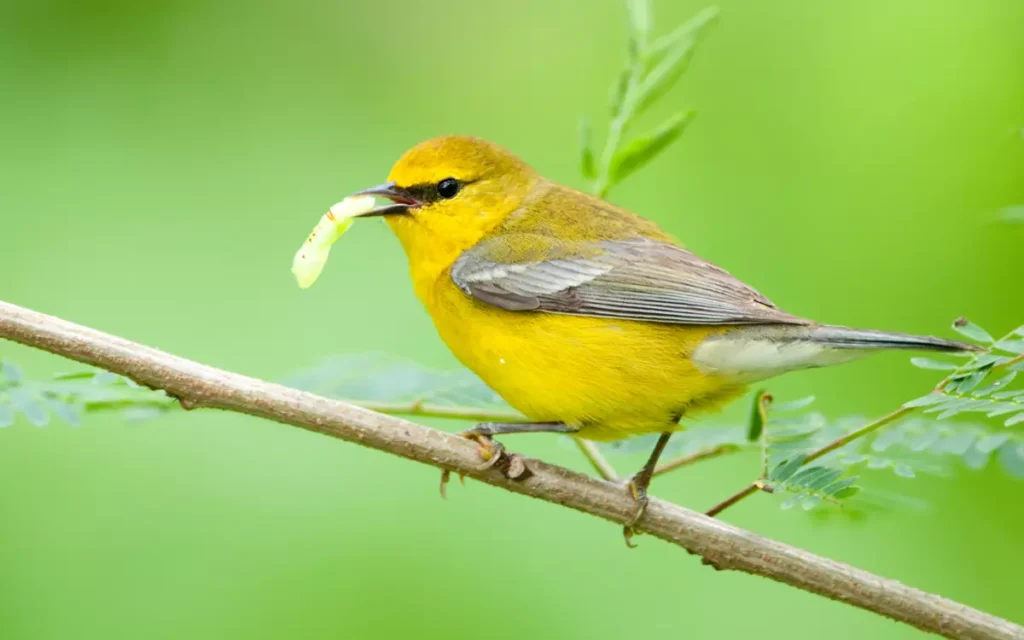
The Blue-winged Warbler is a striking bird known for its bright yellow plumage and distinctive blue-gray wings.
Yearly Presence: Blue-winged Warblers are seasonal visitors to Louisiana, arriving in the spring and departing in the fall.
Breeding Time: Their breeding season typically begins in April or May, with males singing to attract females.
Coloration: Male Blue-winged Warblers exhibit bright yellow plumage with blue-gray wings and a white eye ring. Females have similar coloring.
Egg Laying: These warblers typically lay 3-7 eggs, and the incubation period lasts about 10-12 days. Both parents contribute to raising their chicks.
- Vermivora cyanoptera
- Length: 4.5 – 5.0 in (11.4 -12.7 cm )
- Weight: 0.30 oz (8.5 gm)
- Wingspan : 6.7-7.7 in ( 17-19.5 cm )
7. Prairie Warbler:
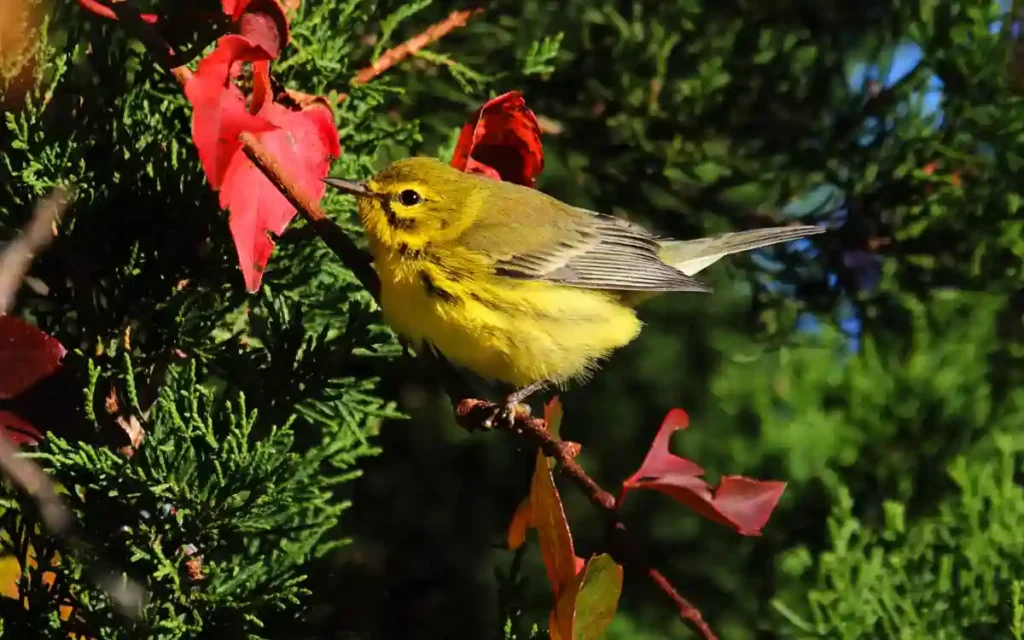
The Prairie Warbler is a small and vibrant songbird with bright yellow plumage and distinctive black streaks.
Yearly Presence: Prairie Warblers are seasonal visitors to Louisiana, arriving in the spring and departing in the fall.
Breeding Time: Their breeding season begins in April or May, with males singing to attract mates and establish territories.
Coloration: Male Prairie Warblers feature bright yellow plumage with black streaks on their sides. They also have a distinctive black eye mask. Females have similar coloring but are less vibrant.
Egg Laying: Prairie Warblers typically lay 3-5 eggs, and the incubation period is approximately 10-12 days. Both parents share the responsibility of caring for their young.
- Setophaga discolor
- Length: 4.3-5.2 in (11 -13 c m)
- Weight: 0.27 oz (7.7 gm )
- Wingspan : 7-7.5 in (18 -19 cm)
8. Wilson’s Warbler:
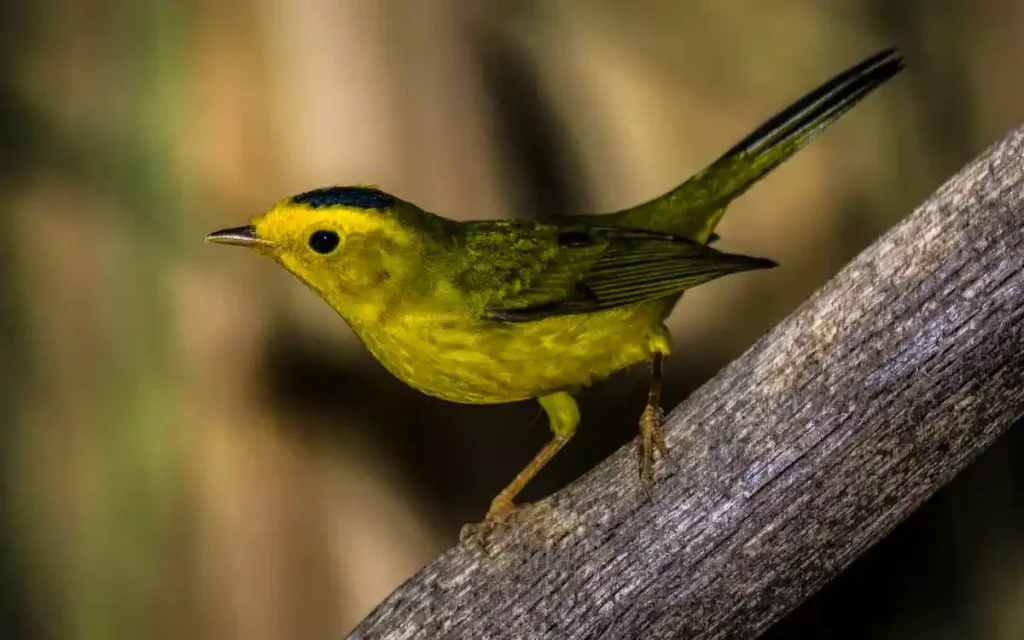
Wilson’s Warbler is a charming migratory songbird with bright yellow plumage and a distinctive black cap.
Yearly Presence: Wilson’s Warblers are seasonal visitors to Louisiana, arriving in the spring and departing in the fall.
Breeding Time: Their breeding season starts in May when they arrive in their northern breeding grounds.
Coloration: Male Wilson’s Warblers have bright yellow plumage with a black cap on their heads. Females have similar coloring but are often duller.
Egg Laying: These warblers typically lay 3-6 eggs, and the incubation period lasts about 10-12 days. Both parents actively care for their nestlings.
- Cardellina pusilla
- Length: 3.9-4.7 in (10-12 cm)
- Weight: 0.18-0.35 oz (5 -10 gm)
- Wingspan : 5.5-6.7 in (14-17 cm)
9. Black-throated Green Warbler:
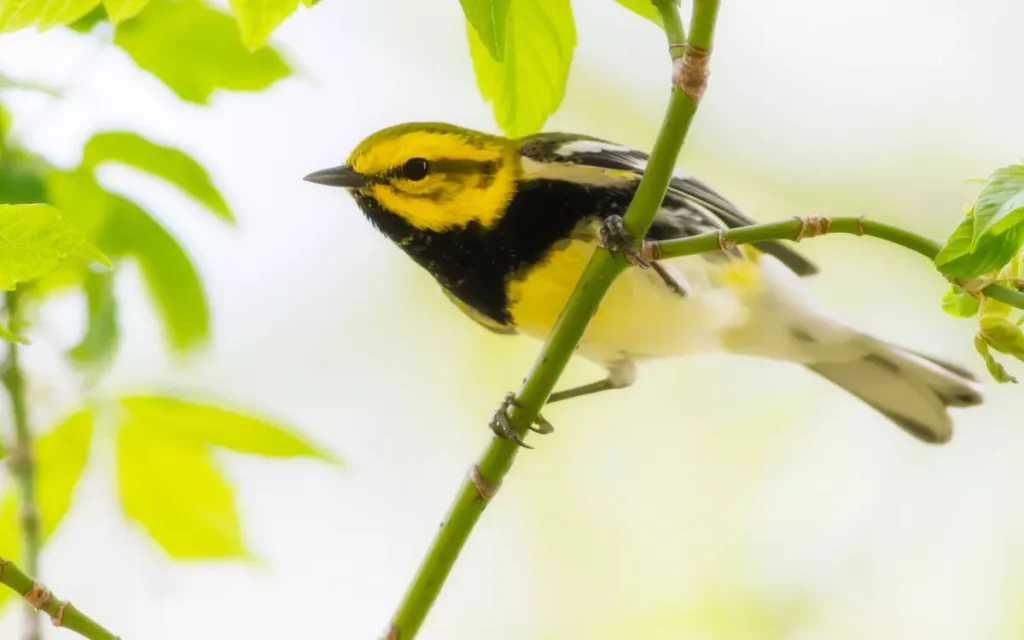
The Black-throated Green Warbler is a charming migratory songbird known for its bright yellow plumage and distinctive black throat.
Yearly Presence: Black-throated Green Warblers are seasonal visitors to Louisiana, arriving in the spring and departing in the fall.
Breeding Time: Their breeding season begins in May when they migrate to their northern breeding grounds.
Coloration: Male Black-throated Green Warblers feature bright yellow plumage with a distinctive black throat and face. Females have similar coloring but are often duller.
Egg Laying: These warblers typically lay 3-5 eggs, and the incubation period lasts about 10-13 days. Both parents are actively involved in raising their young.
- Setophaga virens
- Length: 4.3 – 5 in (11-12 cm)
- Weight: 0.3-0.4 oz (7-11 gm)
- Wingspan: 6.7-7.9 in (17-20 cm)
10. Dickcissel:
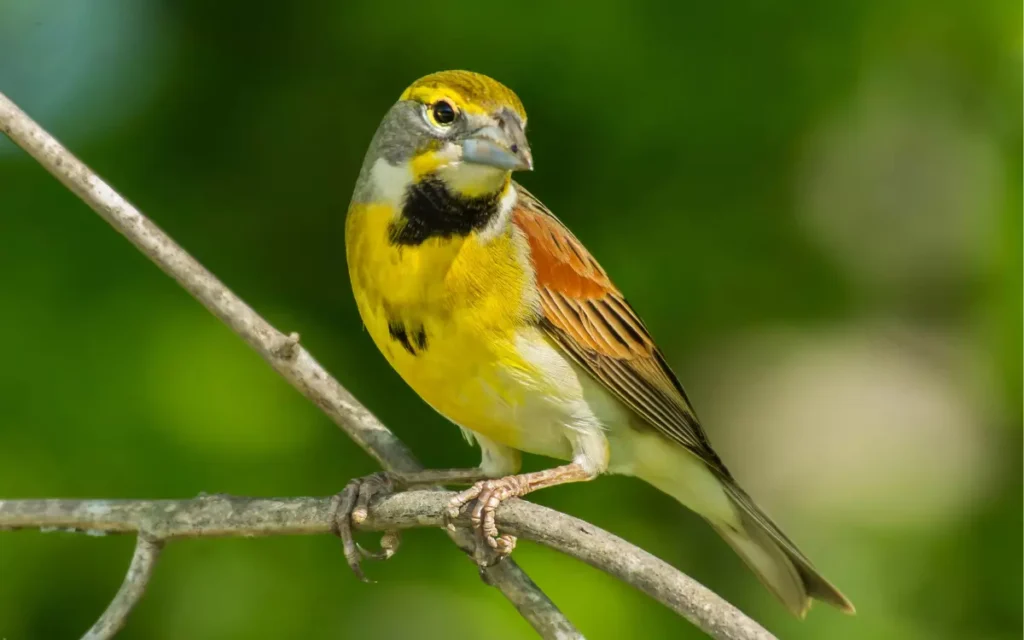
The Dickcissel is a small songbird with bright yellow plumage on its chest and a distinctive black “V” on its throat.
Yearly Presence: Dickcissels are seasonal visitors to Louisiana, arriving in the spring and departing in the fall.
Breeding Time: Their breeding season typically begins in May, with males singing to attract females and establish territories.
Coloration: Male Dickcissels have bright yellow chests with a black “V” on their throats. Females are more subdued in color.
Egg Laying: These songbirds typically lay 3-5 eggs, and the incubation period lasts about 10-12 days. Both parents play an active role in raising their nestlings.
- Spiza americana
- Length: 5.5 – 6.3 in (14 – 16 cm)
- Weight: 0.9-1.4 oz (26 – 40 gm)
- Wingspan: 9.8-10.2 in (25 – 26 cm)
11.Scarlet Tanager Female:
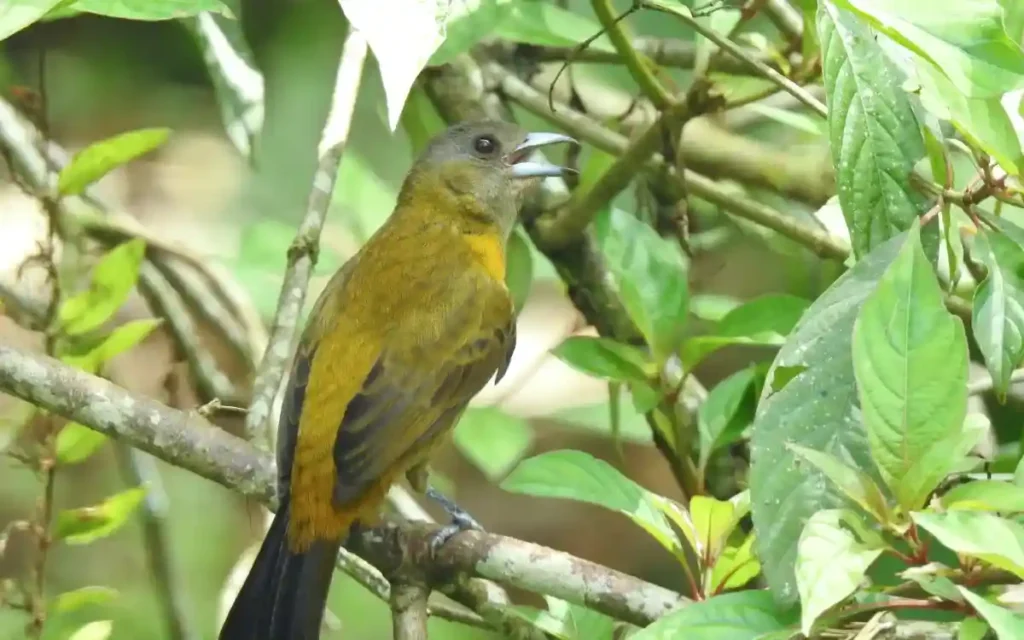
The Scarlet Tanager is a striking bird with bright yellow plumage, often seen during its migratory journey.
Yearly Presence: Scarlet Tanagers are seasonal visitors to Louisiana, arriving in the spring and departing in the fall.
Breeding Time: Their breeding season begins in May when they migrate to their northern breeding grounds.
Coloration: Female Scarlet Tanagers have bright yellow plumage, distinct from the bright red of the males.
Egg Laying: These tanagers typically lay 2-5 eggs, and the incubation period lasts about 11-12 days. Both parents participate in caring for their young.
- Piranga olivacea
- Length: 6.3-7.5 in (16-19 cm)
- Weight: 0.83-1.34 oz ( 23.5-38 gm)
- Wingspan: 9.8-11.8 in (25-30 cm )
12. Yellow-throated Warbler:
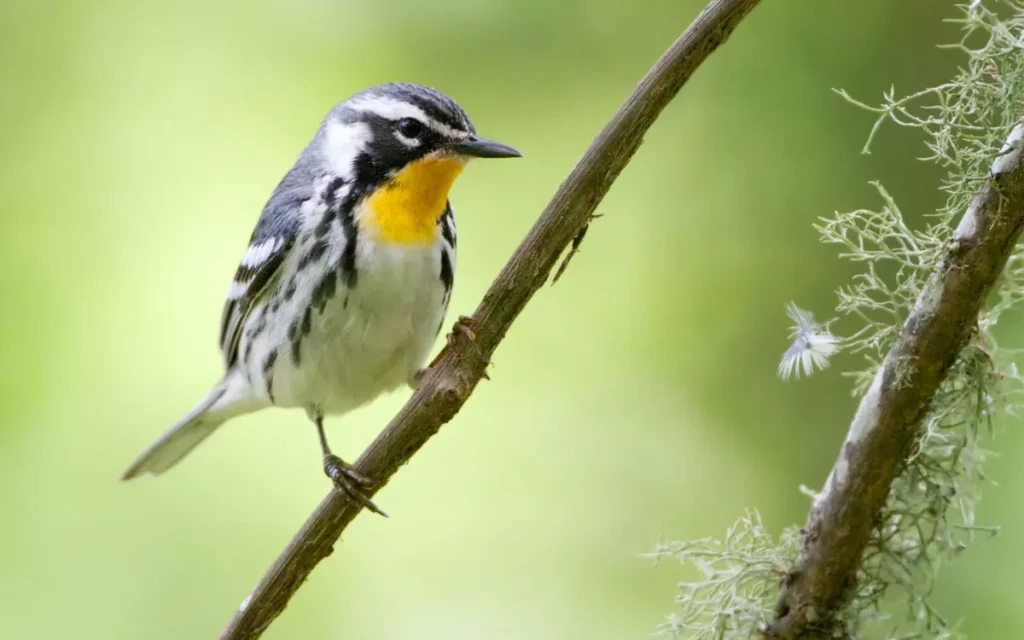
The Yellow-throated Warbler is a striking bird with bright yellow plumage and a distinctive black throat.
Yearly Presence: Yellow-throated Warblers are year-round residents of Louisiana, making them a constant presence in the state.
Breeding Time: Their breeding season typically begins in March, with males singing to attract females and establish territories.
Coloration: Male Yellow-throated Warblers feature bright yellow plumage with a contrasting black throat. Females have similar coloring.
Egg Laying: These warblers typically lay 3-5 eggs, and the incubation period lasts about 12-14 days. Both parents actively care for their nestlings.
- Setophaga dominica
- Length: 5.1-5.5 in(13-14 cm)
- Weight: 0.3-0.4 oz (8.5-11.3 gm)
- Wingspan: 8.3 in (21 cm)
13. Magnolia Warbler:
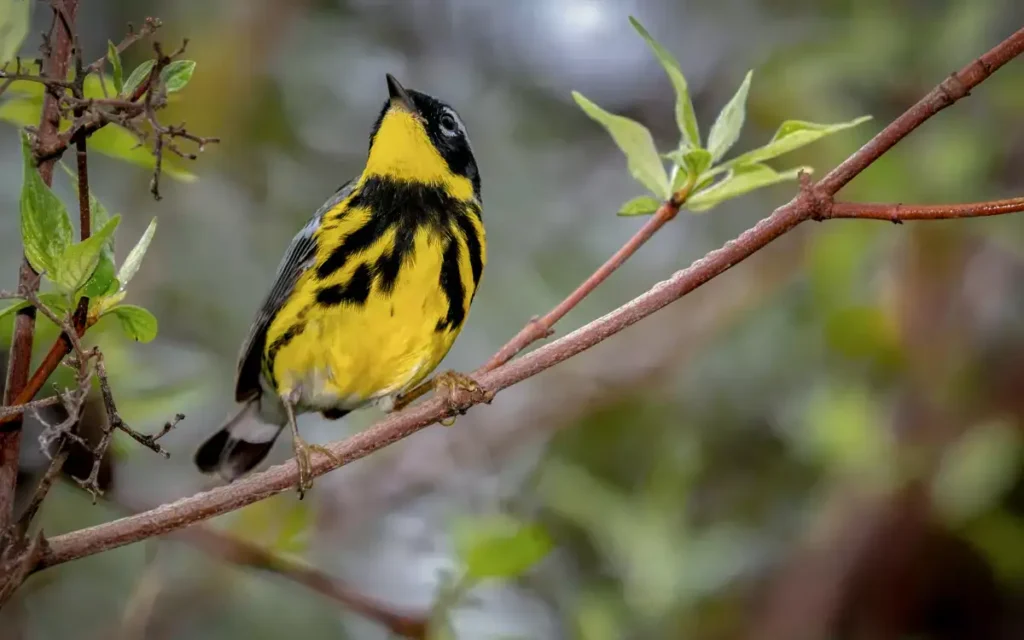
The Magnolia Warbler is a delightful migratory songbird known for its bright yellow plumage and striking black necklace.
Yearly Presence: Magnolia Warblers are seasonal visitors to Louisiana, arriving in the spring and departing in the fall.
Breeding Time: Their breeding season begins in May when they migrate to their northern breeding grounds.
Coloration: Male Magnolia Warblers feature bright yellow plumage with a black necklace and distinctive white wing patches. Females have similar coloring.
Egg Laying: These warblers typically lay 4-5 eggs, and the incubation period lasts about 10-13 days. Both parents share the responsibility of raising their young.
- Setophaga magnolia
- Length: 4.3 – 5.1 in (11-13 cm)
- Weight: 0.2-0.5 oz (6-15 gm )
- Wingspan: 6.3 – 7.9 in (16-20 cm)
14. Baltimore Oriole Female:
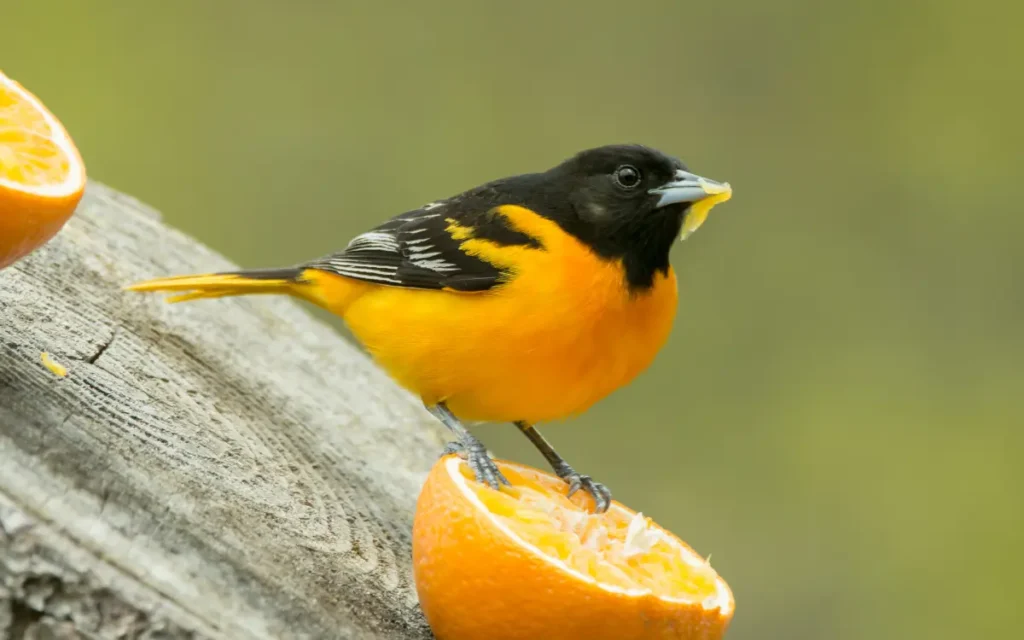
The Baltimore Oriole Female, though not as vibrant as the male, is a charming bird with yellow-orange underparts and a distinctive black crown.
Yearly Presence: Baltimore Orioles are seasonal visitors to Louisiana, arriving in the spring and departing in the fall.
Breeding Time: Their breeding season typically begins in May, with males displaying their vibrant orange plumage to attract females.
Coloration: Female Baltimore Orioles have yellow-orange underparts with a black crown, distinct from the bright orange of the males.
Egg Laying: These orioles typically lay 3-7 eggs, and the incubation period lasts about 12-14 days. Both parents actively participate in caring for their nestlings.
- Icterus galbula
- Length: 6.7-7.5 in (17-19 cm)
- Weight: 1.1-1.4 oz (30-40 gm)
- Wingspan: 9.1-11.8 in (23-30 cm)
15. Palm Warbler:
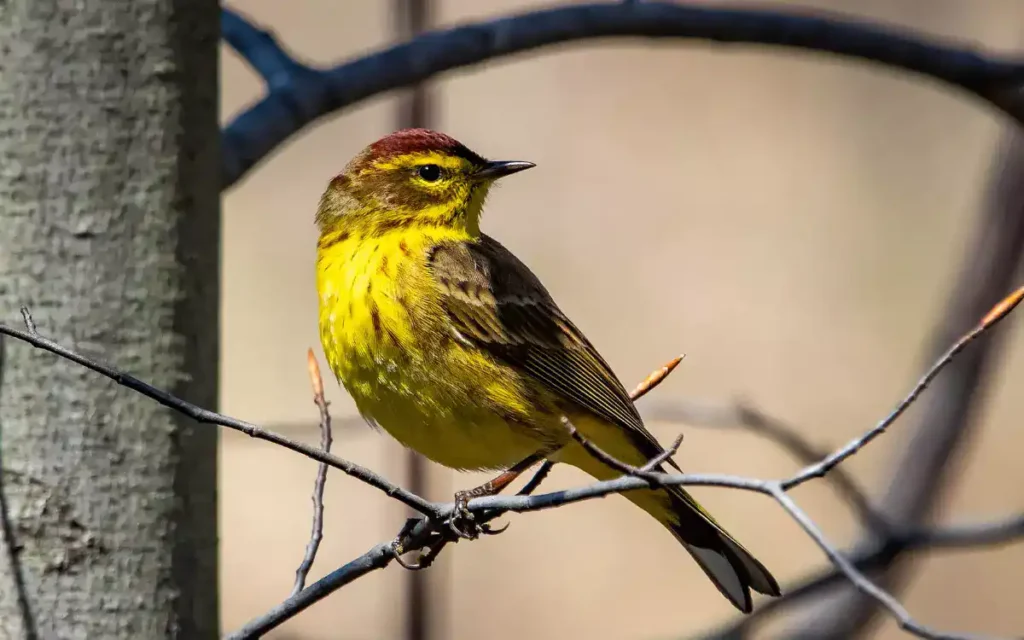
The Palm Warbler is a charming migratory songbird with bright yellow underparts and a distinctive rusty cap.
Yearly Presence: Palm Warblers are seasonal visitors to Louisiana, arriving in the spring and departing in the fall.
Breeding Time:Their breeding season begins in May when they migrate to their northern breeding grounds.
Coloration: Palm Warblers have bright yellow underparts and rusty caps on their heads. They also exhibit a distinctive wagging tail.
Egg Laying: These warblers typically lay 4-5 eggs, and the incubation period lasts about 10-14 days. Both parents share the responsibility of raising their young
- Setophaga palmarum
- Length: 4.7-5.5 in (12-14 cm)
- Weight: 0.3-0.5 oz (8.5-14.2 gm)
- Wingspan: 7.9-8.3 in (20-21 cm)
16. American Redstart Female:
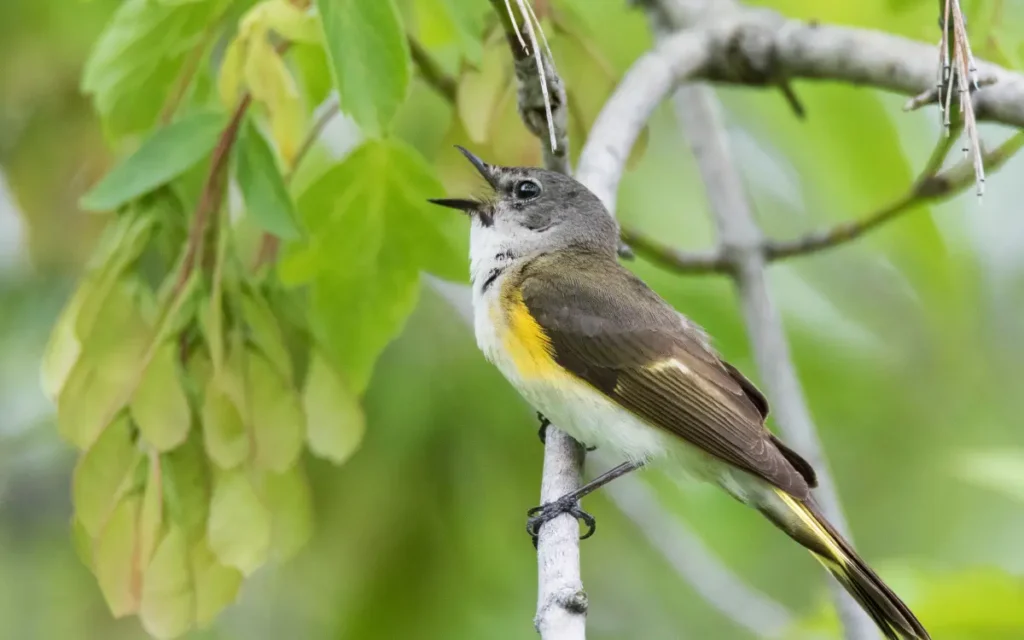
The American Redstart Female, though not as vibrant as the male, is a striking bird with bright yellow patches and a distinctive tail.
Yearly Presence: American Redstarts are seasonal visitors to Louisiana, arriving in the spring and departing in the fall.
Breeding Time: Their breeding season typically begins in May when they migrate to their northern breeding grounds.
Coloration: Female American Redstarts have bright yellow patches on their wings and tails, distinct from the vibrant orange and black of the males.
Egg Laying: These redstarts typically lay 2-5 eggs, and the incubation period lasts about 10-12 days. Both parents actively participate in caring for their nestlings.
- Setophaga ruticilla
- Length: 4.3-5.1 in (11-13 cm)
- Weight: 0.2 – 0.3 oz (6 – 9 gm )
- Wingspan: 0.54 – 0.77(16 – 23cm)
17. Painted Bunting Female:
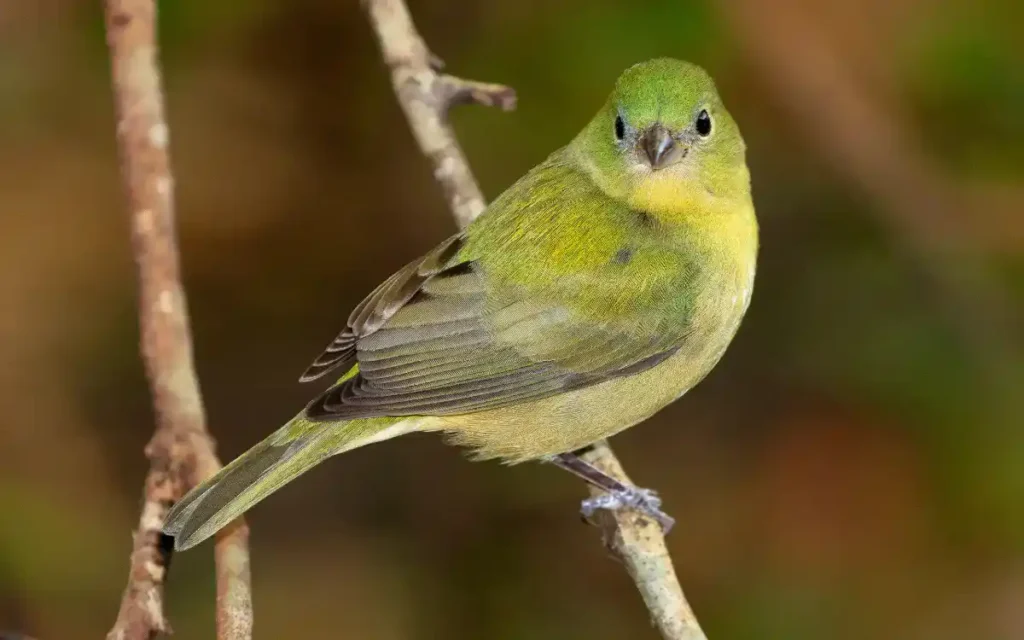
The Painted Bunting, especially its female counterpart, is a charming songbird adorned in subtle yet mesmerizing shades of green and yellow.
Yearly Presence: Painted Buntings are seasonal visitors to Louisiana, gracing the state during the spring and summer.
Breeding Time: Their breeding season typically commences in May when they arrive at their breeding grounds.
Coloration: Female Painted Buntings feature a combination of green, yellow, and brown plumage. While not as vibrant as the males, they possess a unique charm.
Egg Laying: These buntings usually lay 3-5 eggs, with an incubation period lasting about 11-13 days. Both parents share the responsibilities of caring for their nestlings.
- Passerina ciris
- Length: 4.7-5.1 in (12-13 cm)
- Weight: 0.5-0.7 oz (13-19 gm )
- Wingspan: 8.3-9.1 in (21- 23 cm)
18. Prothonotary Warbler:
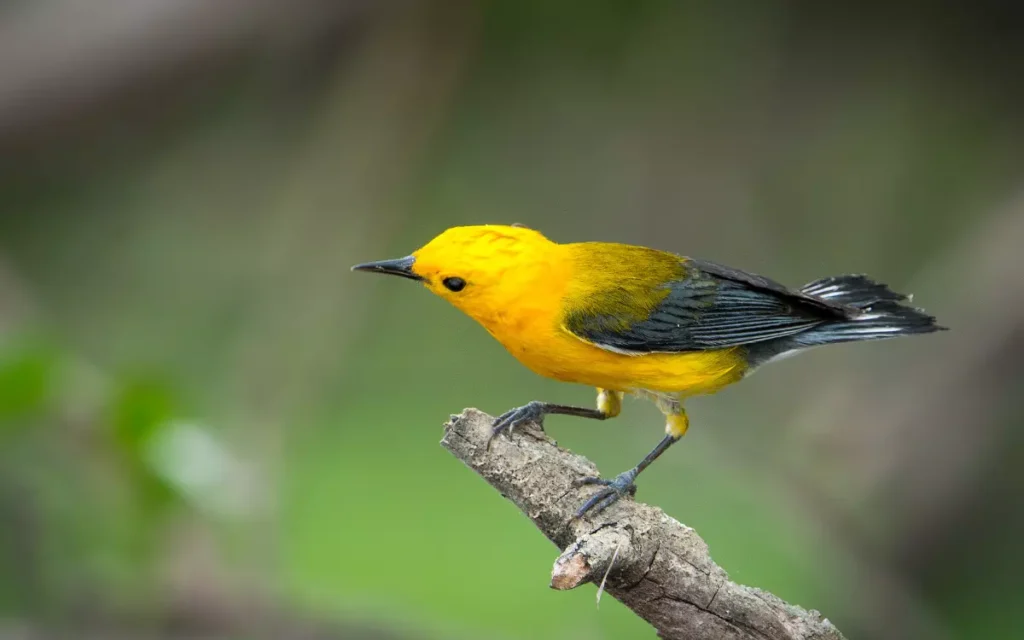
The Prothonotary Warbler is a striking bird with brilliant yellow plumage and a distinctive blue-gray head.
Yearly Presence: Prothonotary Warblers are seasonal visitors to Louisiana, arriving in the spring and staying through the summer.
Breeding Time: Their breeding season typically begins in April when they establish nests in swampy habitats.
Coloration: Prothonotary Warblers boast vibrant yellow plumage, contrasting beautifully with their blue-gray heads.
Egg Laying: These warblers usually lay 3-7 eggs, and the incubation period lasts about 12-14 days. Both parents actively participate in raising their young.
- Protonotaria citrea
- Length:5.1 in (13 cm)
- Weight: 0.44 oz (12.5 gm)
- Wingspan: 8.75 in (22 cm )
19. Cedar Waxwing:
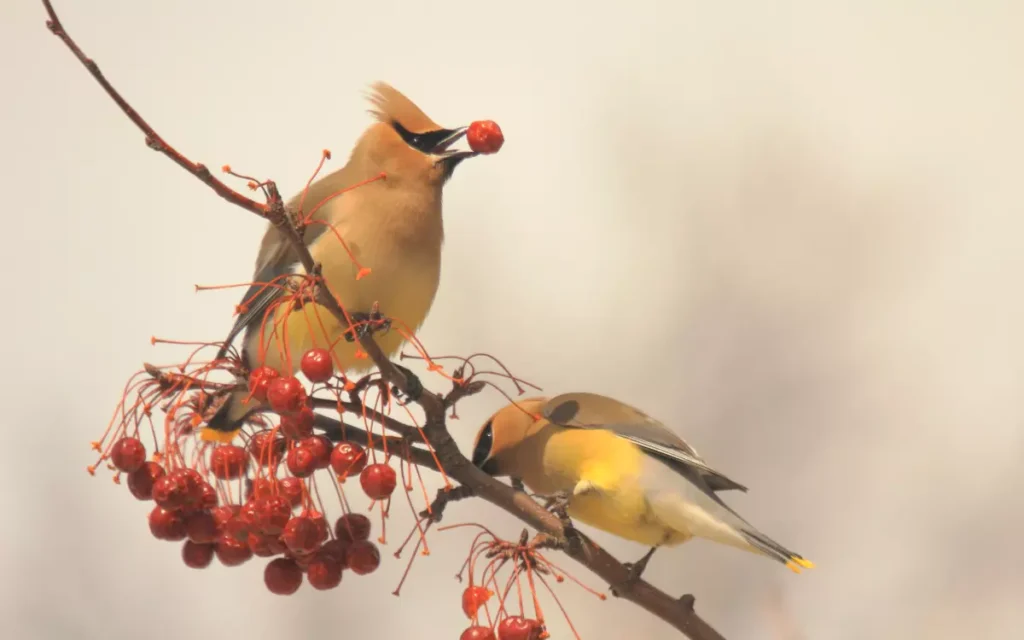
The Cedar Waxwing is a sleek and elegant bird known for its pale yellow belly and distinctive wax-like wingtips.
Yearly Presence: Cedar Waxwings are year-round residents of Louisiana, making them a constant presence in the state.
Breeding Time: Their breeding season typically occurs in the late spring and early summer.
Coloration: Cedar Waxwings feature pale yellow bellies, a black mask, and striking red wingtips with a waxy appearance.
Egg Laying: These waxwings typically lay 2-6 eggs, and the incubation period lasts about 12-16 days. Both parents actively participate in tending to their nestlings.
- Bombycilla cedrorum
- Length: 5.5-7.25 in (14-18.4 cm
- Weight: 1.1 oz (28-32 gm)
- Wingspan: 8.7-12 in (22-30.5 cm)
20. Common Yellowthroat:
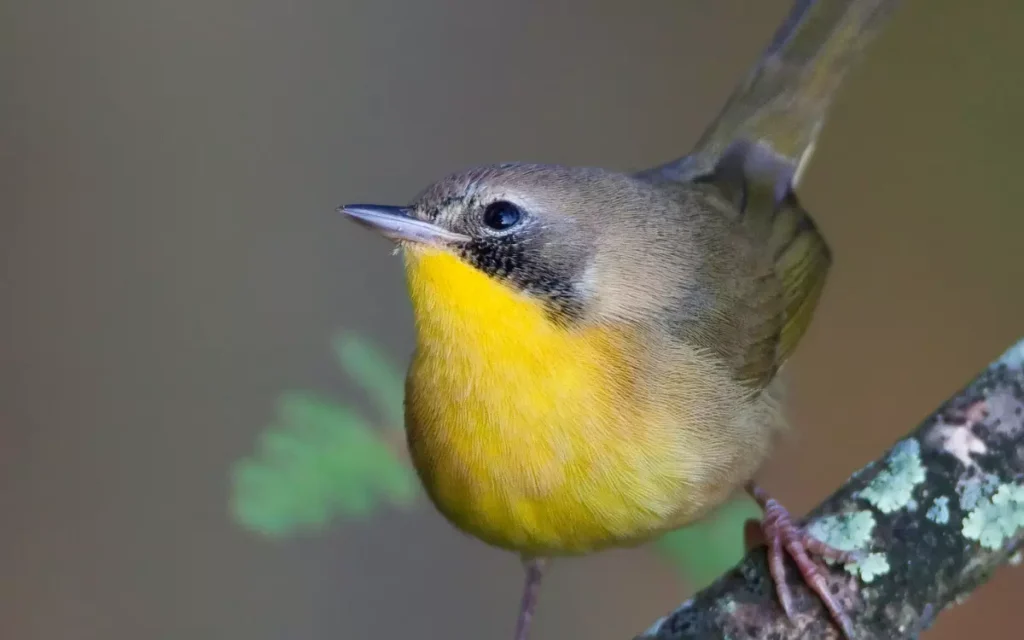
The Common Yellowthroat is a lively bird with a bright yellow throat and a distinctive black mask.
Yearly Presence: Common Yellowthroats are seasonal visitors to Louisiana, arriving in the spring and staying through the summer.
Breeding Time: Their breeding season typically begins in April when they establish nests in wetlands and shrubby areas.
Coloration: These yellowthroats are easily identified by their bright yellow throats and striking black masks.
Egg Laying: This bird typically lays 3-5 eggs, and the incubation period lasts about 10-12 days. Both parents actively participate in caring for their nestlings.
- Geothlypis trichas
- Length: 4.3-5.1 in (11-13 cm)
- Weight: 0.3-0.3 oz (8.5-8.5 gm)
- Wingspan: 5.9-7.5 in (15-19 cm)
21. Pine Warbler:
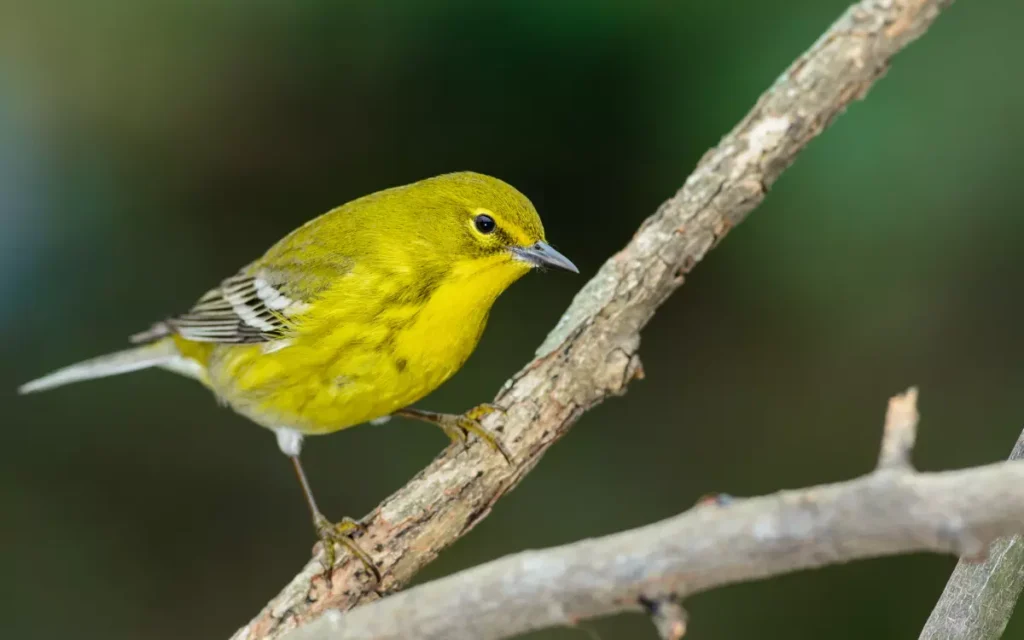
The Pine Warbler is a delightful bird with bright yellow plumage and a sweet, melodious song.
Yearly Presence: Pine Warblers are year-round residents of Louisiana, making them a constant presence in the state.
Breeding Time: Their breeding season typically occurs from March to July, with variations depending on the region.
Coloration:Pine Warblers feature bright yellow plumage, helping them blend in among the pine needles.
Egg Laying:These warblers typically lay 2-5 eggs, and the incubation period lasts about 10-12 days. Both parents actively participate in raising their young.
- Setophaga pinus
- Length: 5.1-5.75 in (13-14 cm)
- Weight: 0.3-0.5 oz (9-15 gm)
- Wingspan: 7.5-9.1 in (19-23 cm)
22. American Goldfinch:
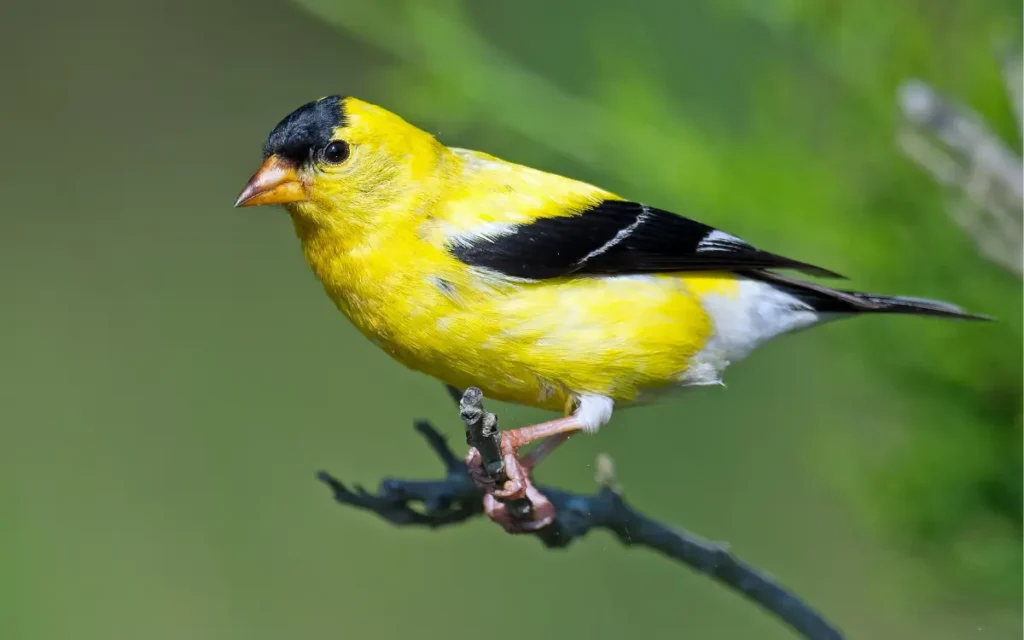
The American Goldfinch, often called the “wild canary,” is a charming bird known for its bright yellow plumage.
Yearly Presence: American Goldfinches are year-round residents of Louisiana, making them a constant presence in the state.
Breeding Time: Their breeding season typically commences in June when they feed their young seeds instead of insects.
Coloration: These goldfinches are renowned for their brilliant yellow plumage, particularly during the breeding season.
Egg Laying: American Goldfinches typically lay 3-7 eggs, and the incubation period lasts about 12-17 days. Both parents actively participate in caring for their nestlings.
- Spinus tristis
- Length: 4.3-5.5 in (11-14 cm)
- Weight: 0.39-0.71 oz (11-20 gm)
- Wingspan: 7.5-8.7 in (19-22 cm)
23. Yellow-rumped Warbler:
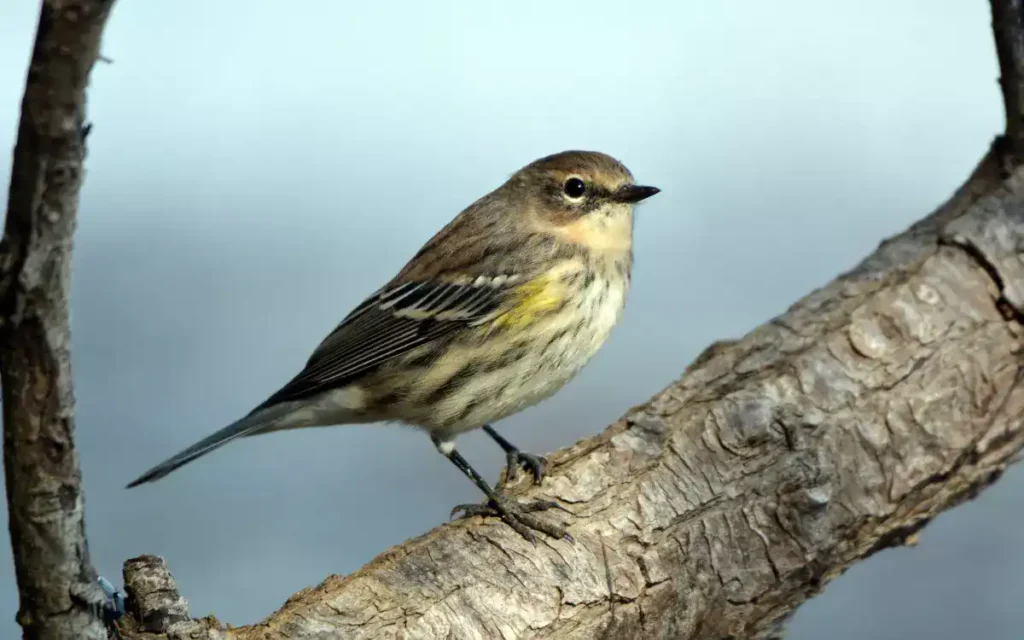
The Yellow-rumped Warbler, often referred to as the “butterbutt,” is a striking bird with bright yellow patches on its rump and sides.
Yearly Presence: Yellow-rumped Warblers are seasonal visitors to Louisiana, arriving in the fall and departing in the spring.
Breeding Time: Their breeding season typically commences in May when they establish nests in coniferous forests.
Coloration: These warblers are easily identified by the yellow patches on their rump, sides, and crown.
Egg Laying: Yellow-rumped Warblers typically lay 4-5 eggs, and the incubation period lasts about 11-13 days. Both parents actively participate in raising their young.
- Setophaga coronata
- Length: 4.7-5.5 in (12-14 cm)
- Weight: 0.4-0.5 oz (12-13 g)
- Wingspan: 7.5-9.1 in (19-23 cm)
24. Eastern Meadowlark:
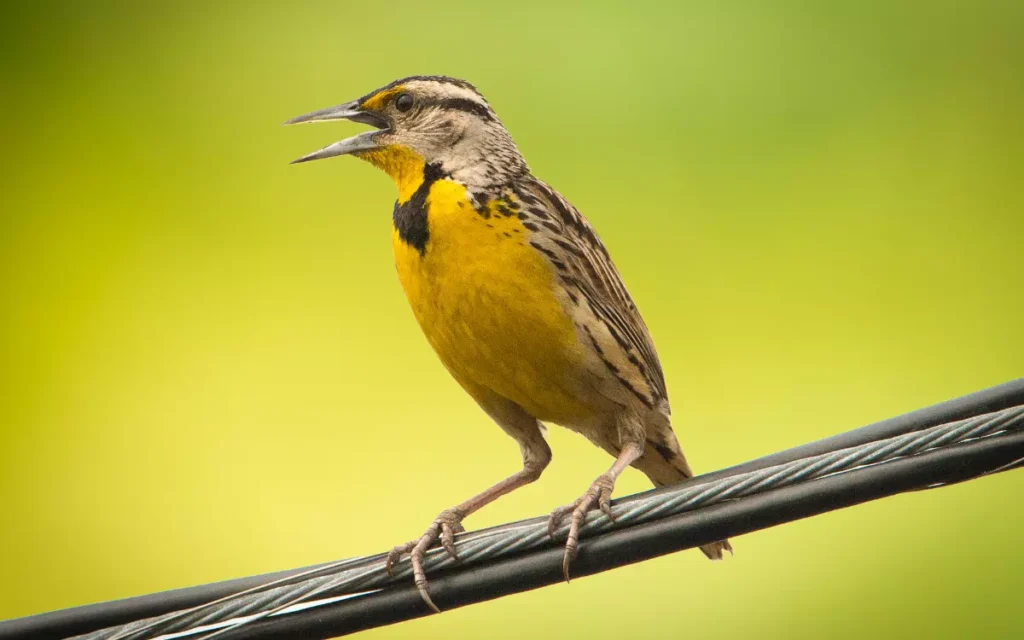
The Eastern Meadowlark is a ground-dwelling bird with a bright yellow belly and a distinctive black “V” on its chest.
Yearly Presence: Eastern Meadowlarks are year-round residents of Louisiana, making them a constant presence in the state.
Breeding Time: Their breeding season typically occurs from March to July, with variations depending on the region.
Coloration: These meadowlarks feature bright yellow bellies and a unique black “V” on their chests.
Egg Laying: Eastern Meadowlarks typically lay 2-6 eggs, and the incubation period lasts about 12-13 days. Both parents actively participate in caring for their nestlings.
- Sturnella magna
- Length: 7.5-11 in (19-28 cm
- Weight: 3.2-5.3 oz (90-150 gm)
- Wingspan: 13.8-15.8 in (35-40 cm)
25. Evening Grosbeak:
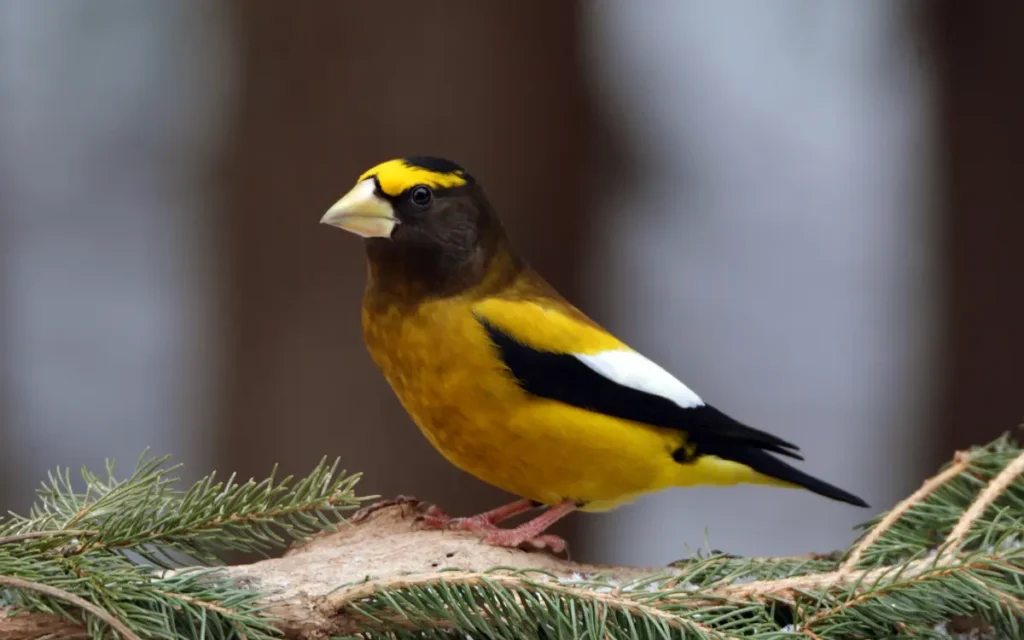
The Evening Grosbeak is a striking bird with bright yellow plumage and a heavy, powerful beak.
Yearly Presence: Evening Grosbeaks are irregular visitors to Louisiana, appearing sporadically in search of food.
Breeding Time: Their breeding season typically occurs in the northern regions of North America.
Coloration: These grosbeaks are renowned for their vibrant yellow plumage and distinctive white wing patches.
Egg Laying: Evening Grosbeaks typically lay 2-4 eggs, and the incubation period lasts about 12-14 days. Both parents actively participate in caring for their nestlings.
- Hesperiphona vespertina
- Length: 6.3-8 in(16-22 cm)
- Weight: 1.9-2.6 oz (53-74 gm)
- Wingspan: 11.8-14.2 in (30-36 cm)
26. Yellow-Breasted Chat:
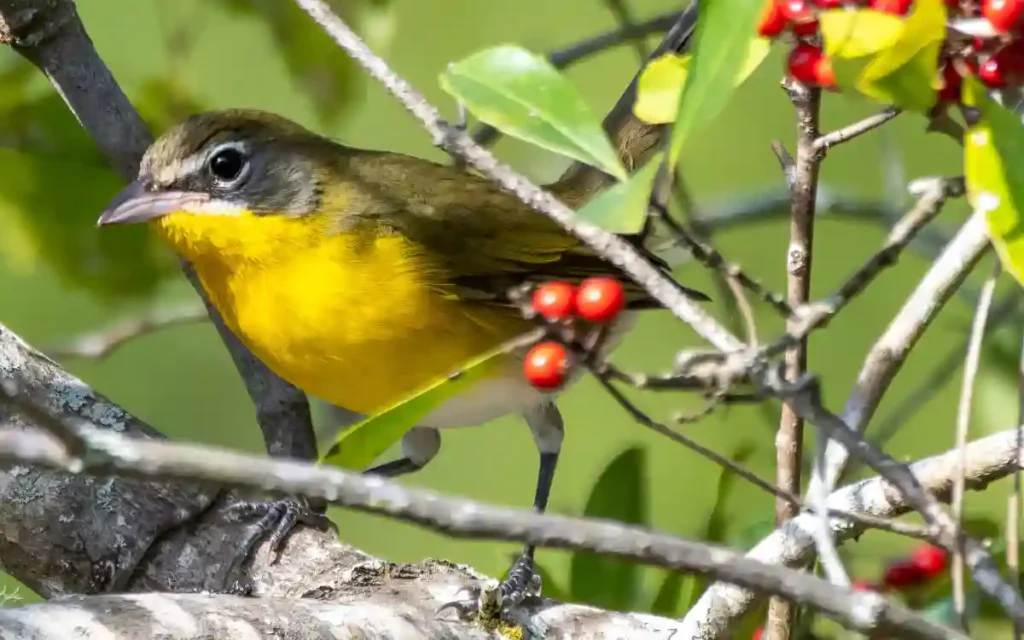
The Yellow-Breasted Chat is a striking North American songbird with a vibrant yellow breast. Despite its name, it’s not a member of the chat family but is part of the warbler family. Known for its elaborate, melodious songs, this bird often prefers dense shrubby habitats. Fun fact: It’s nicknamed the “Swamp Robin” for its vocal prowess and habitat preference.
Yearly Presence: Yellow-Breasted Chats are seasonal visitors to Louisiana, arriving in the spring and staying through the summer.
Breeding Time: Their breeding season typically commences in May when they establish nests in dense shrubs and wetlands.
Coloration: These chats feature bright yellow breasts and a distinctive white “spectacles” pattern around their eyes.
Egg Laying: Yellow-breasted chats typically lay 3-5 eggs, and the incubation period lasts about 12-14 days. Both parents actively participate in raising their young.
- Icteria virens
- Length: 7.1 in (18 cm)
- Weight: 0.8-1.1 oz (23-31 gm)
- Wingspan: 9.8 in (25 cm)
27. Northern Parula:
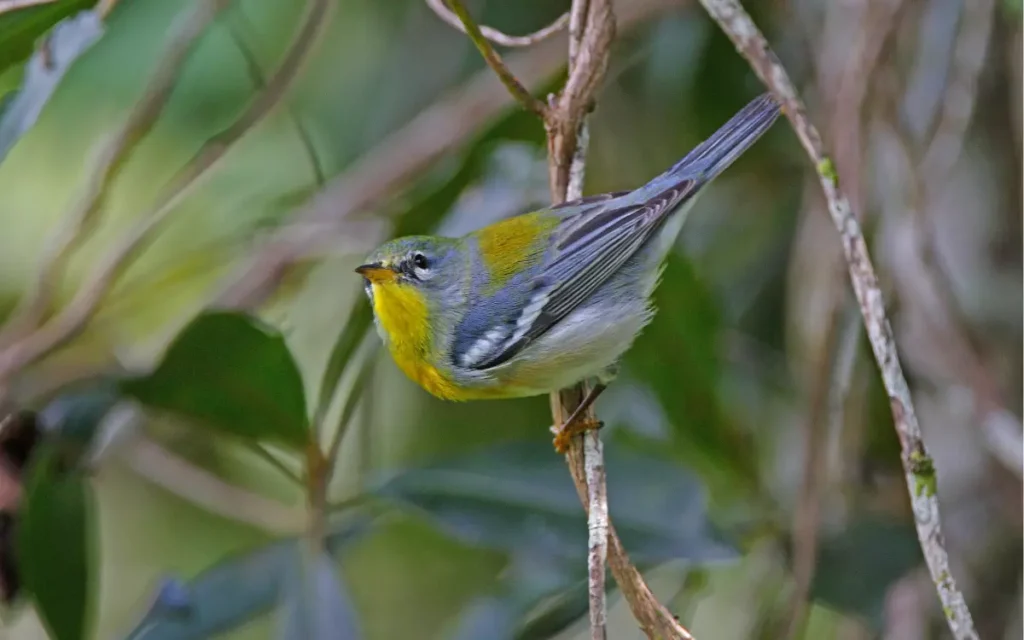
The Northern Parula is a dainty warbler with striking blue-gray and yellow plumage.
They have a remarkable ability to mimic the calls of other bird species, which can confuse birdwatchers trying to identify them based on sound alone.
Yearly Presence: Northern Parulas are seasonal visitors to Louisiana, arriving in the spring and staying through the summer.
Breeding Time: Their breeding season typically commences in April when they establish nests in deciduous trees.
Coloration: showcase a stunning combination of blue-gray and bright yellow plumage.
Egg Laying: Northern Parulas typically lay 3-7 eggs, and the incubation period lasts about 12-14 days. Both parents actively participate in tending to their nestlings.
- Setophaga americana
- Length:4.3-4.7 in (11-12 cm)
- Weight: 0.2-0.4 oz (5-11 gm)
- Wingspan: 6.3-7.1 in (16-18 cm)
28. Hooded Warbler:
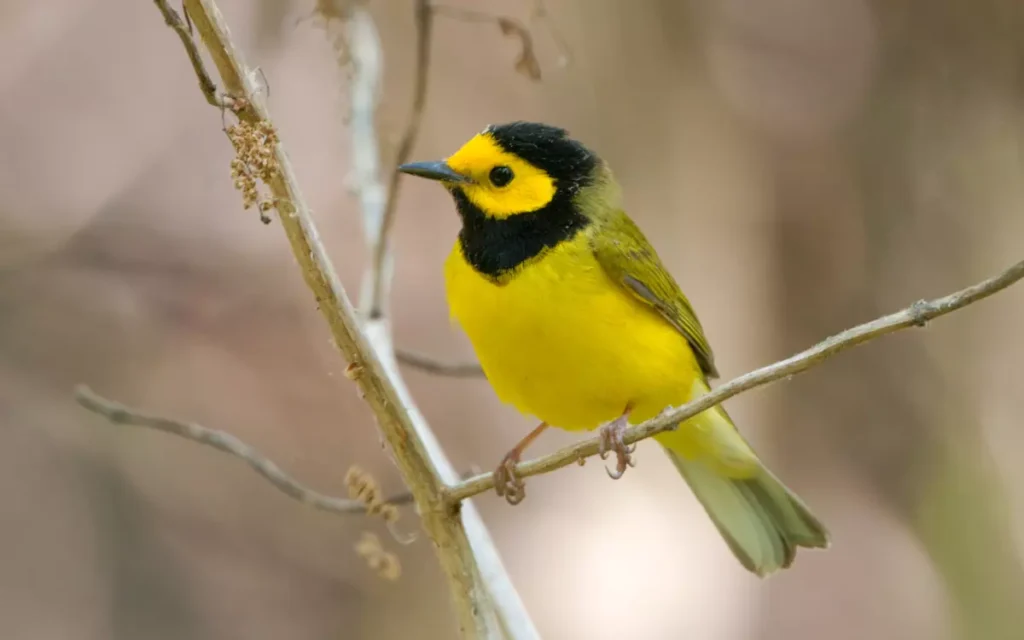
The Hooded Warbler is a striking bird with a black hood and bright yellow plumage.
Hooded Warblers are talented songbirds, known for their clear and melodious songs. Their song is often described as a series of musical phrases that can sound like “weeta-weeto.”
Yearly Presence: Hooded Warblers are seasonal visitors to Louisiana, arriving in the spring and staying through the summer.
Breeding Time: Their breeding season typically commences in April when they establish nests in shrubby woodlands.
Coloration: These warblers are easily identified by their black hood and vibrant yellow plumage.
Egg Laying: Hooded Warblers typically lay 3-5 eggs, and the incubation period lasts about 12-13 days. Both parents actively participate in caring for their nestlings.
- Setophaga citrina
- Length:5.1 in (13 cm)
- Weight:0.3-0.4 oz (9-12 gm)
- Wingspan:6.9 in (17.5 cm)
29. Mourning Warbler:

The Mourning Warbler is a subtle yet charming bird with a gray hood and a yellow belly.They are named for their mournful and sweet song, which is often described as sounding like “whit, whit, whit, whee-oo, whee-oo.” This distinctive song helps birdwatchers locate them.
Yearly Presence: Mourning Warblers are seasonal visitors to Louisiana, arriving in the spring and staying through the summer.
Breeding Time: Their breeding season typically commences in May when they establish nests in dense shrubs.
Coloration: These warblers feature a gray hood and a bright yellow belly, making them an intriguing sight.
Egg Laying: Mourning Warblers typically lay 3-5 eggs, and the incubation period lasts about 12-13 days. Both parents actively participate in raising their young.
- Geothlypis Philadelphia
- Length:3.9-5.9 in (10-15 cm)
- Weight:0.4-0.5 oz (11-13 gm)
- Wingspan: 7.1 in (18 cm)
30. American Yellow Warbler:
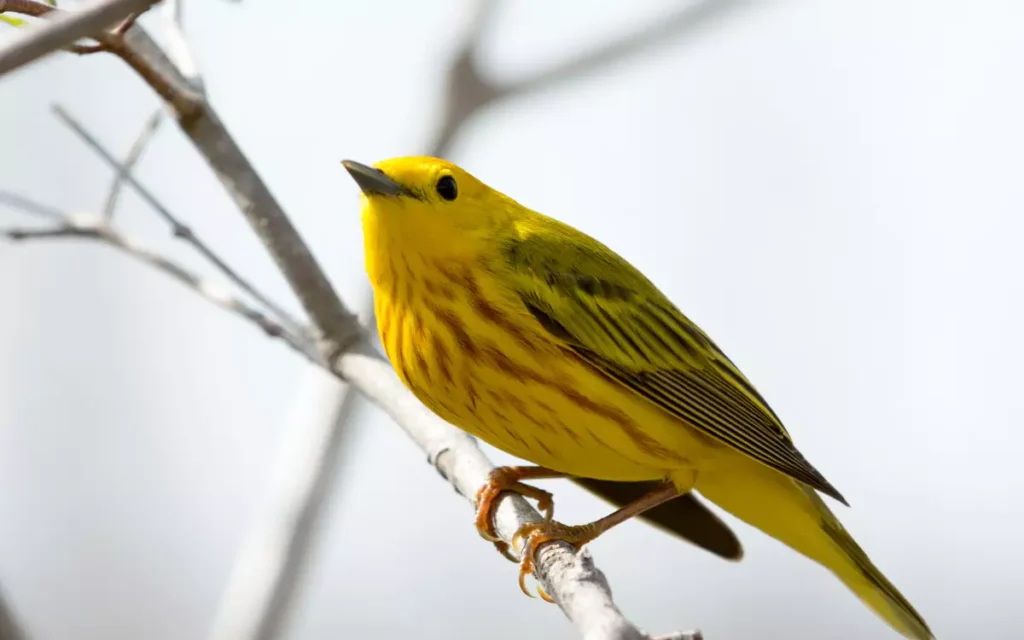
The American Yellow Warbler is a delightful bird with bright yellow plumage and a cheerful song. Their song is often described as a series of repeating musical notes that sound like “sweet-sweet-sweet, I’m so sweet
Yearly Presence: American Yellow Warblers are seasonal visitors to Louisiana, arriving in the spring and staying through the summer.
Breeding Time: Their breeding season typically commences in May when they establish nests in shrubs and wetlands.
Coloration: These warblers are renowned for their vibrant yellow plumage and are often associated with the arrival of spring.
Egg Laying: American Yellow Warblers typically lay 3-6 eggs, and the incubation period lasts about 10-12 days. Both parents actively participate in caring for their nestlings.
- Setophaga petechia
- Length:4.7-5.1 in (12-13 cm)
- Weight:0.3-0.4 oz (9-11 gm)
- Wingspan:6.3-7.9 in (16-20 cm)
You can read also: 31 Louisiana Winter Birds To Explore
Birdwatching Hotspots:
Now that you’re acquainted with the colorful avian residents of Louisiana, it’s time to plan your birdwatching adventure. Here are some of the best locations to observe these birds in their natural habitat:
1. Atchafalaya Basin
The Atchafalaya Basin, with its extensive swamps and waterways, is a prime spot for spotting Prothonotary Warblers, Scarlet Tanagers, and Northern Cardinals.
2. Kisatchie National Forest
Kisatchie National Forest offers diverse habitats, making it an excellent location for birdwatching. Look for Summer Tanagers and American Goldfinches among the trees.
3. New Orleans Audubon Park
Even in the heart of New Orleans, you can find a variety of birds, including Baltimore Orioles, amidst the lush vegetation of Audubon Park.
4. Lake Martin
Lake Martin, near Lafayette, is known for its birdlife, particularly Western Tanagers during migration season.
5. Maurepas Swamp Wildlife Management Area
This swampy area is a haven for Prothonotary Warblers and other wetland birds.
6. Cameron Prairie National Wildlife Refuge
For a chance to see a wide range of colorful birds, including Northern Cardinals, head to this wildlife refuge on the Gulf Coast.
FAQs:
Q: What time of year is best for birdwatching in Louisiana?
A: The best time for birdwatching in Louisiana is during the spring and early summer, as this is when many migratory species, such as Scarlet Tanagers and Baltimore Orioles, are present.
Q: Do I need special equipment for birdwatching in Louisiana?
A: While a pair of binoculars is highly recommended, you don’t need elaborate equipment to enjoy birdwatching in Louisiana. A field guide and a keen eye are all you need to get started.
Q: Are these birds easy to spot?
A: Some of the birds, like Northern Cardinals and American Goldfinches, are relatively common and easy to spot in gardens and parks. Others, like the Scarlet Tanager and Western Tanager, may require more effort and a bit of luck.
Q: Can I participate in organized birdwatching tours in Louisiana?
A: Yes, many tour operators offer guided birdwatching tours in Louisiana. These tours can provide valuable insights and increase your chances of spotting rare birds.
Q: Are there any birdwatching clubs or communities in Louisiana?
A: Yes, Louisiana has several birdwatching clubs and communities where enthusiasts share their experiences and knowledge. Joining one can be a great way to connect with fellow birdwatchers.
Q: Are there any conservation efforts for these birds in Louisiana?
A: Yes, Louisiana has various conservation initiatives aimed at protecting the habitat of these colorful birds, especially those that rely on wetlands and forests.
Conclusion:
We hope you enjoyed learning about the 49 Red, Orange, and Yellow Birds in Louisiana. These colorful birds make Louisiana’s nature even more beautiful. Keep an eye out for them next time you’re outdoors.




